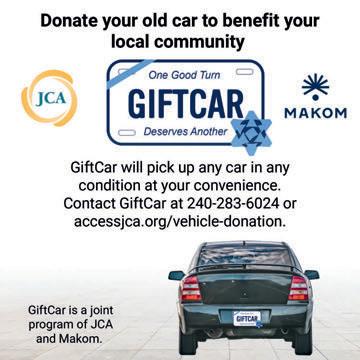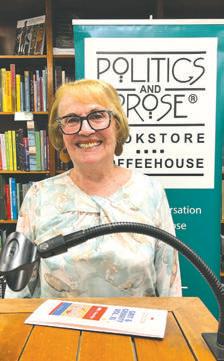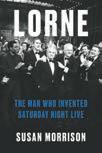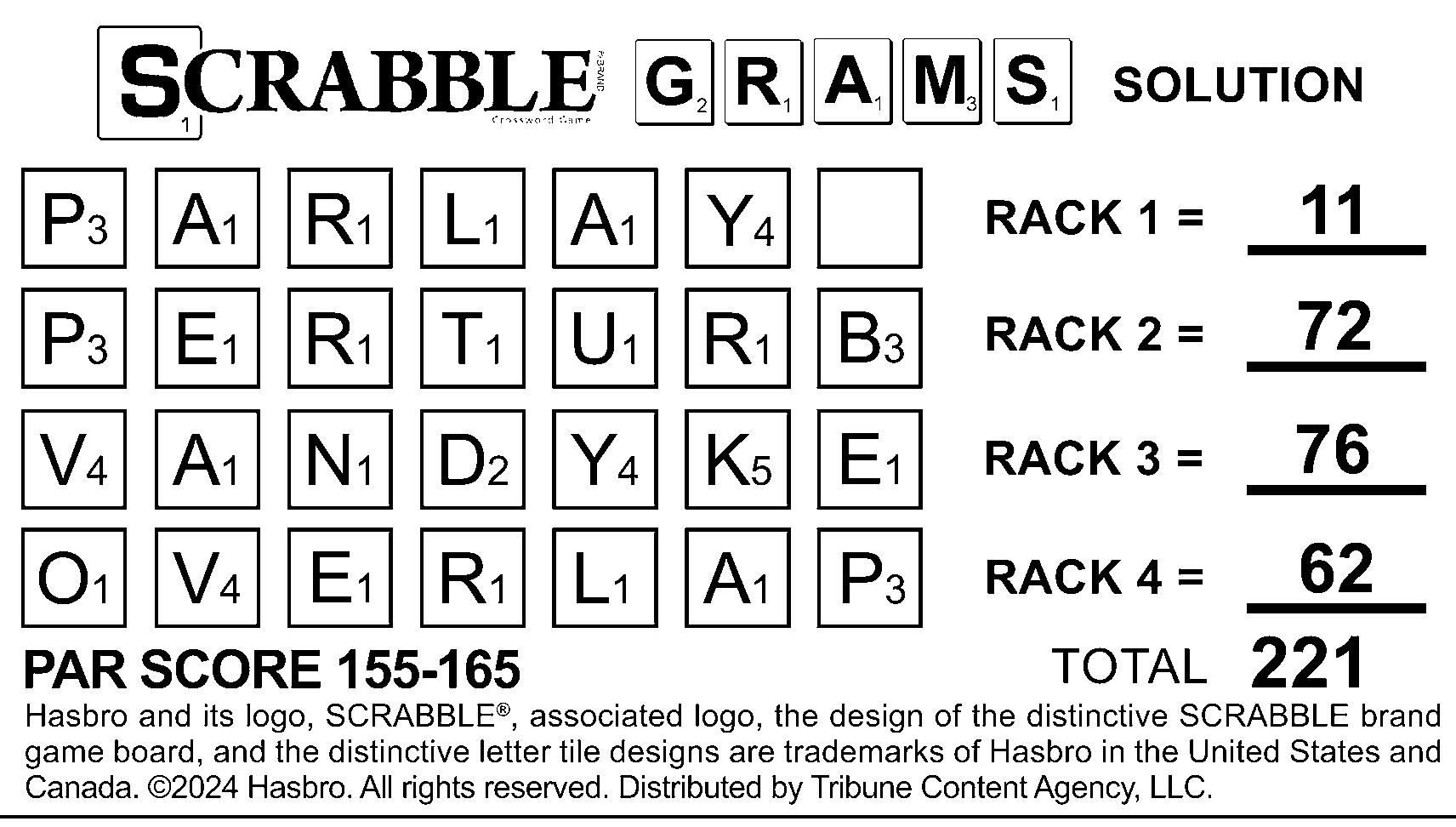
More than 200,000 readers throughout Greater Washington


More than 200,000 readers throughout Greater Washington
By Margaret Foster
Jazz singer Vanessa Rubin, 68, learned her craft from icons like Sarah Vaughn. Although she couldn’t afford a ticket to every show, she would watch through the window of the club.
“Sometimes they would let you in because they knew you were trying to learn,” she said. “I’d go to gigs and sit down with pencil and paper. I’d study them; study what they do in the moment.
“They come with all that age and wisdom and all that know-how, and you’re not going to be able to do that at 25…We stand on all their shoulders, all the people who have come before us.”
Last year, Rubin visited the Duke Ellington School of the Arts in Washington, D.C. to pass on some of her know-how. She and her trio invited students to watch them rehearse before a performance at Blues Alley downtown.
“We just sat there like three friends who wanted to make some good music, and we laughed, and we talked and just let the students sit there and watch,” she said. “You can’t teach them how to be in the moment.
My ‘classroom’ is performing. That’s the only way I can teach, is through performance.”
Rubin will perform on opening night of the DC JazzFest this year. It’s her first appearance at the annual festival, which will take place on Labor Day weekend, Aug. 27 through 31.
More than 100 concerts will take place all over town during the festival, including at the Kennedy Center and The Hamilton DC, culminating on the last night at the Wharf in Southwest.
Baltimore-born saxophonist Gary Bartz, 84, a two-time Grammy winner, will headline at this year’s DC JazzFest. Like


Rubin, Bartz learned from the greats, including Art Blakey and Miles Davis; in fact, he played with them as a member of their bands.
Bartz’s parents were his “best supporters,” he said. His father owned a club in downtown Baltimore, and Bartz started his musical education there.
“Listening is learning, if you know how
to listen. I actually knew how to play before I got a saxophone. I don’t know anyone who could listen better and harder than Miles [Davis].”
Although the building that housed his father’s club still exists, it’s not a music venue anymore.

Hop aboard a small cruise ship to see Japan’s lesser-known coastal villages and national parks; plus, plan a road trip to Massachusetts to mark our nation’s 250th anniversary page 26

First-time authors and old pros are included in this year’s anthology of women writers in D.C.; plus, take the grandkids to The Little Mermaid, and Bob Levey on downsizing page 29
Find
So much of the world around us is undetectable by human senses. We see only a narrow slice of the light spectrum. Our hearing? Just a small band of sound. Many animals perceive far more than we do.
But through technology, we’ve learned to harness parts of the electromagnetic spectrum that we can’t see or hear. With the right tools, we translate those invisible waves into everyday essentials: radio, television, cell phones, GPS. We never perceive the waves directly, but we trust they exist. How else would our devices work?
spiritual dimensions of the universe — gets screened out.

By Stuart P. Rosenthal
That same logic might apply to the spiritual realm. Maybe it’s all around us, but we lack an internal “device” to perceive it.
Some scientists and philosophers are now exploring the idea that our brains function more like filters than receivers of truth — tuning out much of reality so we can focus on just what we need to survive.
In this view, the brain isn’t the pinnacle of evolution, but a narrow-band radio picking up only essential stations: eat, sleep, find shelter, get along with others. Everything else — including potentially vast
This theory finds support in some surprising places. Studies of brainwaves in people undergoing psychedelic experiences, for example, show not the hyperactivity most scientists expected, but rather a quiescent brain almost bereft of electrical impulses.
Many people on a “trip” see vivid colors, hear music, feel as if they’re floating through space, merging with the universe, and accessing deep truths they can’t quite explain later. And these rich experiences inexplicably arise when their brain’s usual electrical activity seems to fade away.
Could it be that when our brains — designed to pick up only a narrow sliver of reality — quiet down, we become more open to other spiritual, emotional or intuitive frequencies? Maybe what we call a mystical experience is just the widening of our perceptual bandwidth.
This might explain why belief in a spiritual realm remains strong among American adults. According to the Pew Research

The Beacon is a monthly newspaper dedicated to inform, serve, and entertain the citizens of the Greater Washington DC area, and is privately owned. Other editions serve Greater Baltimore and Howard County, Md.
Subscriptions are available via first-class mail ($36) or third-class mail ($12), prepaid with order. D.C. and Maryland residents: add 6 percent for sales tax. Send subscription order to the office listed below.
Publication of advertising contained herein does not necessarily constitute endorsement. Signed columns represent the opinions of the writers, and not necessarily the opinion of the publisher.
Publisher/Editor Emeritus – Stuart P. Rosenthal
President/Associate Publisher – Judith K. Rosenthal
Executive Vice President – Gordon Hasenei
Editor – Margaret Foster
Art Director – Kyle Gregory
Vice President of Operations – Roger King
Advertising Representatives –Jill Joseph, Steve Levin, M.K. Phillips, Alan Spiegel
Assistant Editor – Ana Preger Hart
Editorial Assistant – Tori Cleveland
Editorial Intern – Luke Sanelli



The Beacon, P.O. Box 2227, Silver Spring, MD 20915
(301) 949-9766 • Email: info@thebeaconnewspapers.com Website: www.theBeaconNewspapers.com
Submissions:
Center’s 2024 Religious Landscape Study, roughly eight in 10 — including many who identify as religiously unaffiliated — believe there is something spiritual beyond the physical world.
Around 83% say they believe in God or a universal spirit, and 86% overall (including 74% of those under 30) believe humans have a soul or spirit.
Throughout most of history, belief in unseen realms was nearly universal. But it’s somewhat surprising to see such beliefs holding steady today.
Maybe it’s less surprising to find this among older adults, since it is said that, as we age, people tend to become more religious or spiritual. That observation is often attributed to older people contem-
plating the end of life.
But maybe it’s not just fear of death that draws us toward spirituality. As we slow down or leave behind high-pressure lifestyles, released from the need to focus our brains on raising children and making a living, maybe we naturally begin to tune into different frequencies.
Are you finding yourself more spiritual than you used to be? Are there moments when you feel connected to something larger — even if you can’t quite name it?
I’d love to hear your thoughts. Share your reflections with us by mail, email or through our website. I look forward to tuning in, and to sharing your experiences with other readers.

Readers are encouraged to share their opinions on any matter addressed in the Beacon as well as on political and social issues of the day. Mail your Letter to the Editor to The Beacon, P.O. Box 2227, Silver Spring, MD 20915, or email to info@thebeaconnewspapers.com. Please include your name, address and telephone number for verification.
Dear Editor:
Kudos to the publisher, Stuart P. Rosenthal, for constantly putting out an excellent Beacon newspaper. It is always educational, informative and entertaining.
The July cover story about the parachuting team jump was breathtaking and mindblowing. Bob Levey, the national awardwinning columnist, still looks fantastic on his 80th birthday. He is always intellectually stimulating and morally uplifting.
The Beacon is a miracle worker; please keep up the excellent work.
Larry Calhoun Capitol Heights, MD
Dear Editor:
Loyal Beacon readers and I were discussing the publisher’s “vanishing” into the ether of strange music after reading your June column “Music From the ether.” We were all relieved to have found you again in “As others see us” in July. Phew!
You hit the epicenter of what adults should be pondering as we transition from one life to another. I have personally interviewed people that have had out of body near-death experiences, and they all have much in common. Their point of view of themselves and others changes dramatically.
Many people avoid thinking about, much less answering, these startling questions: Who are you, really? What are you here on Earth for? What matters most?
Review your life and try to see yourself as others see you. It’s not about what you have, but what you have become. To that end, your article was spot-on, thought-pro-
voking and a great read. Welcome back from the ether.
Richard Todd Washington, DC
Dear Editor:
Regarding Victor Block’s interesting article on the Amtrak Auto Train: I am an experienced traveler on the Auto Train and can comment from a coach perspective. Being tall, I’ve never had any trouble sleeping in the coach areas, and coach seating is much less expensive. If you do consider coach travel, here are some other tips: Avoid the busiest months (January traveling south and mid-April through the end of May traveling north). That way, you’ll have an empty seat next to you, which allows you to stretch out while sleeping.
Unfortunately, the food Amtrak provides for coach passengers ranks about the same as a typical microwave meal. I usually carry on a modest dinner. A good continental breakfast is still provided in the morning.
Though the train is relatively quiet, earplugs, eye patches and melatonin can help one stay asleep. Bring a small pillow, as Amtrak no longer provides them to the coach passengers.
David Bisant via email
Dear Editor:
Montgomery County planners have approved a sweeping redevelopment plan for a 3.5-mile stretch of University Boulevard, despite opposition from residents, who say















































































































































Doctors want to change the term for early prostate cancer, since it’s often harmless
BALANCING ACT
Medication, diabetes and improper footwear can make you unsteady on your feet
DINNER AT YOUR DOORSTEP
Meal delivery kits can be healthy. Some arrive ready-made; others require cooking ADVERSE ADVIL
Don’t exceed six ibuprofen pills per day; more can cause ulcers or kidney damage
By John Miley
As artificial intelligence (AI) gets better at interpreting images, the tech industry is setting its sights on healthcare. Cue the AI radiologist.
The futuristic vision includes AI providing an accurate analysis of multiple medical scans, combining it with an understanding of patient history, and delivering a personalized diagnosis and course of treatment.
When paired with a trained clinician, AI tools have the potential to improve the quality of care, save time and expand access to specialist expertise, among other benefits, according to a new paper, “Multimodal generative AI for medical image interpretation,” in the medical journal Nature
The authors say early research suggests that AI “could one day match human expert performance in generating reports across disciplines, such as radiology, pathology and dermatology.”
Interpreting medical images and writing reports is a time-consuming challenge for human specialists, who may make mistakes or take a long time to release results.
Many current AI medical tools have narrow uses, like finding specific issues in a certain type of scan. A future AI model could have an expansive knowledge of multiple
types of scans, all sorts of medical conditions and a range of treatments to recommend.
Tech giants and start-ups alike see huge moneymaking potential. Microsoft, Google and OpenAI all have AI models or research in medical imaging.
Start-up Harrison.ai recently raised $112 million in funding to speed up diagnoses for radiologists, calling its widely used tool “a second set of eyes for clinicians.”
Microsoft is working with major hospitals on AI tools to interpret thousands of conditions, trying to tap into the tens of billions of dollars health systems spend annually on imaging and uncover cost savings.
“Generative AI has transformative potential to overcome traditional barriers in AI product development and to accelerate the impact of these technologies on clinical care,” said Keith J. Dreyer, D.O., Ph.D., chief data science officer and chief imaging officer at Mass General Brigham, in a news release last summer about the Microsoft collaboration.
Risk of inaccuracy, tampering
But there are “formidable obstacles” to finding a truly helpful AI assistant in radiol-
ogy, notes the paper. AI models have been plagued by biases, inaccuracies and socalled hallucinations — the industry term for made-up answers, including false or misleading text that sounds authoritative. Those types of flaws are nonstarters in a high-stakes medical setting unless there are strict guardrails.
There are also concerns that AI could overlook rare diseases for different populations, plus cyber fears of the tools being tampered with to deliver certain results, “leading to overprescription, insurance fraud and falsifying clinical trials,” says the paper. However, AI models are getting better and multiple models can be used together for better results.
One thing the researchers make clear: “Human evaluation is critical.” AI tools for medical imaging need doctors to fine-tune them and better benchmarks so they can be tested and improved. Hospitals need to agree on metrics to decide when and how to rely on AI.
In the near term, AI could become a reliable assistant to clinicians, taking initial readings, drafting preliminary reports and even answering questions via a chatbot.
Increased use of generative AI will seriously pick up in coming years, aiming to save time for radiologists and help train the next generation of students.
The future for patients includes interacting with an AI doctor about test results and getting answers or even treatment suggestions in plain language. Also likely: getting a second opinion from one or multiple AI models, rather than a real doctor.
The hope is patients will have higher compliance with treatment and better outcomes through being able to ask a lot more questions and not feeling rushed during a short visit with a human doctor.
In the meantime, be wary of using free public AI tools for medical advice with your own medical scans. Uploading personal images and medical information poses big privacy risks, on top of concerns about accuracy.
So, are human radiologists on the road to extinction? No, it’s likely human judgment remains solidly in the loop, even as AI greatly improves. Plus, future regulations may prevent AI from completely taking charge.
© 2025 The Kiplinger Washington Editors, Inc. All rights reserved. Distributed by Tribune Content Agency, LLC.
By Christy Bieber
Loneliness can increase your risk of early death. This has been conventional wisdom for a long time.
Past research has shown a clear connection between social isolation and mortality, and two years ago the U.S. Surgeon General even published a lengthy advisory on the “epidemic” of loneliness and isolation that was putting Americans at risk.
Of course, it also seems intuitive that a person lacking in social connections would suffer consequences that impact their physical health, as no one likes to be lonely.
Now, however, new research is calling into question this long-held belief and, surprisingly, found that loneliness may not be quite the threat that we all once thought it was.
In fact, the problem may be one of confusing cause and effect.
To gain further insight into the relationship between loneliness and health, researchers conducted a global study of home care recipients across three countries.
More than 300,000 older adults were included in the study, with home care recipients chosen for the research because this population is likely to have high rates of loneliness due to complex health needs and mobility issues. This differed from other loneliness studies, many of which focused on the general population.
Surprisingly, these researchers discovered that lonelier individuals actually fared better than those with stronger social connections, stating, “the risk-adjusted rates of mortality were consistently lower among lonely home care clients than among those who were not lonely.”
While between 15% and 25% of home care recipients included in the study ex-
hibited loneliness, those with more complex health issues and reduced levels of activity were the most likely to be lonely — yet, their risk of death was still lower.
This meant, contrary to past evidence, this research showed that “when adjusting for age-related confounding factors, loneliness is not predictive of increased mortality risk.”
Researchers were not entirely sure why this study data was so different from past research.
However, one theory suggests that the prior research does not get the relationship right between loneliness and mortality.
Many of the past studies are focused on the general population, for whom loneliness is associated with poor health status, But loneliness is also associated with both advanced age and depressive symptoms in this population. Both of those factors may
be the explanation for the early death rather than the loneliness itself.
Because the population in this latest research is focused on home care recipients, it’s also possible that those who were the sickest received the most time with caregivers. This added interaction with caregivers may have reduced the risks of loneliness among this vulnerable group.
Some past research also suggests that people who are lonelier have higher healthseeking behavior, which could result in better health outcomes and a reduced mortality risk.
Lastly, researchers suggested that there’s a possibility that “loneliness may be a consequence of those health changes [that lead to mortality] rather than their cause.” In other words, changes related to advancing health may both make people
From page 4
more lonely and more likely to pass away.
How to protect yourself
This research should provide some comfort to older people struggling with social connections, in that it reveals being lonely is not necessarily as deadly as feared.
However, while the specific relationship between loneliness and death is unclear, it is clear that loneliness is a factor that affects well-being to some degree.
So, while maintaining social connections can become more challenging without the structure of work or the increase in connections that come with raising young chil-
dren, it remains important for retirees to continue to build strong social networks.
Joining clubs, making regular plans with friends and neighbors, volunteering, and enjoying nature with others are all possible ways to tackle the loneliness problem.
Those who are experiencing more serious health issues may also benefit from increased time with caregivers who can reduce their feelings of isolation, especially if this latest research is correct that the link between loneliness and increased mortality is actually caused by the health issues that both increase the risk of death and the risk of social isolation.
© 2025 The Kiplinger Washington Editors, Inc. All rights reserved. Distributed by Tribune Content Agency, LLC.
• Nurture your relationships through consistent, frequent and high-quality engagement with others. Take time each day to reach out to a friend or family member.
• Seek out opportunities to serve and support others, either by helping your family, co-workers, friends or strangers in your community or by participating in community service.
• Be responsive, supportive and grateful to others. As we practice these behaviors, others are more likely to reciprocate.
• Participate in social and community groups (fitness, religious, hobby, professional, and community service organizations) to foster a sense of belonging, meaning and purpose.
• Reduce practices that lead to feelings of disconnection from others. These
include disproportionate time in front of screens instead of people.
• Seek help during times of struggle with loneliness or isolation by reaching out to a family member, friend, counselor, health care provider or the 988 crisis line.
• Make time for civic engagement. This could include being a positive and constructive participant in political discourse and gatherings (e.g., town halls, school board meetings, local government hearings).
• When interacting with others, ask yourself these key questions: How might kindness change this situation? What would it look like to treat others with respect? How can I be of service? How can I reflect my concern for and commitment to others?
U.S. Surgeon General

For free materials about area housing communities, just complete and clip this coupon and mail, or take a picture and email, to the Beacon. #
Housing Communities
District of Columbia
o Chevy Chase House (See ad on page 15)
o Inspīr Embassy Row (See ad on page 7)
Maryland
o Brooke Grove (See ad on page 19)
o ChurchillSeniorLiving (See ad on page 8)
o Grandview,The/Erickson (See ad on page 9)
o Homecrest House (See ad on page 13)
o Park View Bladensburg (See ad on page 30)
o Park View Columbia (See ad on page 30)
o Park View Emerson (See ad on page 30)
o Park View Laurel (See ad on page 30)
o Riderwood/Erickson (See ad on page 1, 9)
o Willow Manor at Cabin Branch (See ad on page 16)
o Ashby Ponds/Erickson (See ads on pages 1, 9)
o Culpepper Gardens (See ad on page 17)
o Greenspring/Erickson (See ads on pages 1, 9)
o WoodleighChase/Erickson (See ad on page 9)
o Alzheimer’s Clinical Trials ConsortiumLiBBY Study
(See article on page 10 and ad on page 11)
o Anxiety/Depression Study (See ad on page 10)
o Smell Test Study (See ad on page 10)
Check the boxes you’re interested in and return this form to: The Beacon, P.O. Box 2227, Silver Spring, MD 20915 or take a picture and email to housing@thebeaconnewspapers.com.
By Caroline Thomason
Maintaining strong, healthy bones is a cornerstone of healthy aging, and it requires a combination of proper nutrition, adequate energy intake and consistent weight-bearing exercise.
Those who eat a diet high in fruits, vegetables, nuts, dairy, lean proteins and whole grains have better bone health, according to the USDA.
Essential nutrients like vitamins D and K, magnesium and protein help build and maintain bone density. Incorporating specific foods rich in these nutrients into your diet can significantly impact bone health as you age and reduce the risk of osteoporosis and fractures.
Here are six of the best foods to eat to make sure your bones are resilient throughout your life:
Join a free walk/run with music, breakfast, giveaways and a panel on trail running. The Running Industry Diversity Coalition (RIDC) is hosting
Back Outside: DC on Sat., Sept. 13 from 10 a.m. to 1 p.m. and starts at the REI plaza, 201 M St. NE, Washington, DC. Registration required. For more information and registration, visit bit.ly/BackOutsideDC.
This free online series with AARP explains the fundamentals of pickleball while exploring the “pillars” of brain health. This six-part boot camp happens every Sunday at noon from Aug. 3 to Sept. 14. Registration and AARP account required. For more information and to register, visit https://bit.ly/PickleballAARP.








Dairy. Dairy products are rich sources of calcium, vitamin D and protein. Calcium is essential for building and maintaining strong bones, while vitamin D enhances calcium absorption and bone growth. Protein supports bone structure and repair.
Consuming dairy products like milk, cheese and yogurt can provide these vital nutrients, helping to prevent osteoporosis and maintain bone density throughout life.
Leafy greens. Leafy greens are rich in vitamin K content. Vitamin K plays a crucial role in bone metabolism by helping to regulate calcium and promoting the binding of calcium to the bone matrix, which strengthens bones.
Eating leafy greens like kale, spinach and broccoli can significantly contribute to maintaining bone density.
Collagen. Collagen is essential for bone health, as it provides the structural framework for bones, contributing to their strength and flexibility.
As a major protein found in the body, collagen supports our bones as well as surrounding tissues like joints, skin and connective tissue. It helps maintain bone density and integrity, reducing the risk of fractures and osteoporosis, particularly in postmenopausal women.
Collagen-boosting foods include bone broth, proteins, zinc and copper-dense foods








(e.g., beans, beef and chicken), and vitamin C-rich foods (e.g., citrus fruits and peppers).
Nuts. Nuts have a high magnesium content, which is crucial for bone formation and maintenance. Magnesium helps in the conversion of vitamin D into its active form, enhancing calcium absorption and supporting bone density.
Prunes. Prunes are uniquely beneficial for bone health due to their composition of vitamin K, potassium, boron and polyphenols, which support bone density and may reduce the risk of fractures. They also contain dietary fiber, calcium and magnesium, which may improve nutrient absorption and reduce inflammation.
Research shows that regular consumption of prunes can improve bone mineral density and prevent bone loss in postmenopausal women.
Salmon. Salmon is an excellent food for healthy bones because it provides vitamin D and omega-3 fatty acids. Vitamin D works together with calcium for proper absorption, while consuming omega-3s may reduce bone breakdown and improve inflammation.
Reprinted with permission from Environmental Nutrition, a monthly publication of Belvoir Media Group, LLC, 1-800829-5384, EnvironmentalNutrition.com. © 2025 Belvoir Media Group. Distributed by Tribune Content Agency, LLC.
We meet you where you are to help ou feel better, live safer and stay onnected to what you love. Healing owered by heart, backed by a team who knows you.


loved ones dealing with memory loss. And su hat’s why we created Oceana Memory Care,
upporting them by an exclusive program
With every detail designed to provide whole-person wellness. See memory care in a new way at inspirseniorliving.com.
By C.W. Schmidt
Roughly one in six men will be diagnosed with prostate cancer at some point in their lives, but these cancers usually aren’t life-threatening. Most newly diagnosed men have Grade Group 1 (GG1) prostate cancer, which can linger for years without causing significant harm.
Prostate cancer is categorized according to how far it has spread and how aggressive it looks under the microscope. Pure GG1 prostate cancer is the least risky form of the disease. It occurs frequently
with age, will not metastasize to other parts of the body, and it doesn’t require any immediate treatment.
So, should we even call it cancer? Many experts say no.
Dr. Matthew Cooperberg, who chairs the department of urology at the University of California, San Francisco, said men wouldn’t suffer as much anxiety — and would be less inclined to pursue unneeded therapies — if their doctors stopped referring to low-grade changes in the prostate as cancer.
Last year he co-chaired a symposium
The 2025 Northern Virginia Olympics take place Sept. 13 through Sept. 30, with more than 70 events. Registration is open now to Aug. 29 at nvso.us ($20 fee covers unlimited events). Participants must be 50+ and reside in a sponsoring jurisdiction. Events are held at 29 venues and are grouped by age and gender. For more information and registration, visit nvso.us.
People 55 and up are invited to join a free volunteer-led exercise program to improve muscular strength, bone density and balance. Weekly classes take place Tuesdays and Thursdays from Sept. 2 through Nov. 25 from 12:30 to 1:30 p.m. at Kensington Park Library, 4201 Knowles Ave., Kensington, MD. Registration opens Aug. 12 and is required. For more information and registration, visit bit.ly/BoneBuildClass or call (240) 773-9515.
where experts from around the world gathered to discuss the pros and cons of giving GG1 cancer another name.
Treatment discrepancies
GG1 cancer is typically revealed by PSA screening. The goal with screening is to find more aggressive prostate cancer while it’s still curable, yet these efforts often detect GG1 cancer incidentally.
Attendees at the symposium agreed that GG1 disease should be managed with active surveillance. With this standard practice, doctors monitor the disease with periodic PSA checks, biopsies, and imaging, and treat the disease only if it shows signs of progression.
But even as medical groups work to promote active surveillance, 40% of men with low-risk prostate cancer in the United States are treated immediately. According to Cooperberg, that’s in part because the word “cancer” has such a strong emotional impact. “It resonates with people as something that spreads and kills,” he said.
“No matter how much we try to get the message out there that GG1 cancer is not an immediate concern, there’s a lot of anxiety associated with a ‘C-word’ diagnosis.”
A consequence is widespread overtreatment, with tens of thousands of men needlessly suffering side effects from surgery or radiation every year.
normal but nonlethal growth in tissue. Skeptics expressed a concern that patients might not stick with active surveillance if they aren’t told they have cancer.
But should men be scared into complying with appropriate monitoring? Cooperberg argues that patients with pure GG1 “should not be burdened with a cancer diagnosis that has zero capacity to harm them.”
Cooperberg does caution that since biopsies can potentially miss higher-grade cancer elsewhere in the prostate, monitoring the condition with active surveillance is crucial.
Moreover, men with a strong family history of cancer, or genetic mutations such as BRCA1 and BRCA2 that put them at a higher risk of aggressive disease, should be followed more closely, he said.
Dr. Marc Garnick, the Gorman Brothers Professor of Medicine at Harvard Medical School and Beth Israel Deaconess Medical Center, and editor in chief of the Harvard Medical School Guide to Prostate Diseases, agrees. He emphasized that a name change for GG1 cancer needs to consider a wide spectrum of additional testing.
“This decision can’t simply be based on pathology,” he said. “Biopsies only sample a miniscule portion of the prostate gland. Genetic and genomic tests can help us identify some low-risk cancers that might behave in a more aggressive fashion down the road.”










A cancer diagnosis has other harmful consequences: studies reveal negative effects on relationships and employment as well as “someone’s ability to get life insurance,” Cooperberg said. “It can affect health insurance rates.”
Experts at the symposium proposed that GG1 cancer could be referred to instead as acinar neoplasm, which is an ab-
Meanwhile, support for a name change is gaining momentum. “Younger pathologists and urologists are especially likely to think this is a good idea,” Cooperberg said. “I think the name change is just a matter of time — in my view, we’ll get there eventually.”
C.W. Schmidt is editor of the Harvard Medical School Annual Report on Prostate Diseases.
© 2025 Harvard University. Distributed by Tribune Content Agency, LLC.


Dr k rna Park, , Annapolis,






By Margaret Foster
Dementia is a cruel disease, not only for the patient but everyone in their orbit. People with advanced dementia may become agitated and angry.
“Agitation in the later stages of life with dementia can be a devastating symptom for both participants and their loved ones and caregivers,” said Brigid Reynolds, Georgetown University faculty member and co-principal investigator of a new study for dementia patients.
But the go-to medications to treat agitation, such as narcotics, anti-psychotics and benzodiazepines, come with unpleasant side effects.
“Available treatments often have unwanted side effects like sedation, falls or
itching. And they often don’t work to treat the agitation,” Reynolds said.
“We’re very aware of significant caregiver burden associated with agitation symptoms at the end of life. We’d like to find something to improve quality of life at the end of life,” Reynolds said.
Nicknamed the LiBBY Study, the trial will determine if an oral combination of tetrahydrocannabinol (THC) and cannabidiol (CBD) is effective in treating agitation in hospice-eligible participants with dementia. It will also evaluate whether or not the oral combination of THC and CBD can help to reduce potential side effects of medications typically used to calm patients.
“This is the first of its kind study,” Reynolds said. “This is the first time THC-
The Accessibility Lab Presenter Series is an online monthly event that brings together the disability, assistive technology and accessibility communities to share information and to network. This month’s presentation will be on Sat., Aug. 16 from 1 to 2:30 p.m. over Zoom. For more information and the Zoom link, visit bit.ly/AccessLabDC, call (202) 727-2142 or contact DCPLaccess@dc.gov.
CBD has been tested in this population.”
People age 40 and over who have dementia and agitation may be eligible for the LiBBY Study. “You don’t have to have severe dementia to be in this study,” Reynolds noted. But potential participants should be in hospice or be eligible for hospice. Her study team will help determine eligibility.
In this 12-week study, visits may take place at the participant’s residence. Each visit lasts from one to two hours. In between home visits, the study team will check in with the caregiver by phone.
The study is a randomized, double-blind trial, meaning that participants will be randomly assigned to take a digestible oil that
Ongoing smell loss may be one of the most important signals of brain health as we age.
A new study from The Michael J. Fox Foundation for Parkinson’s Research is exploring this link. We’re calling on everyone with and without Parkinson’s to request a simple scratch-and-sniff test and contribute to important research.
Request your test at
or scan the QR code.
Request your test at 877-525-PPMI (7764) mysmelltest.org/beacon or scan the QR code.
is either THC-CBD or a placebo. At the end of 12 weeks, all study participants are invited to participate in a 12-week extension without the chance of getting the placebo.
The LiBBY Study is funded by the National Institutes of Health’s National Institute on Aging and coordinated by the Alzheimer’s Clinical Trials Consortium.
There are 13 clinical trial sites that are enrolling participants in the LiBBY study, including the University of Maryland School of Medicine, Howard University and Medstar Georgetown University Hospital.
For more information, see libbystudy.org or contact the Memory Disorders Program a Georgetown University at leah.pulinat @ georgetown.edu or (202) 687-9078.
Join Walter Reed for a memory café with fun activities and discussions to engage the brain for people with early-stage memory loss. The café meets on the first and third Thursdays of the month from 1:30 to 3 p.m. at the Walter Reed Community Center, 2909 16th St. S, Arlington, VA. Registration recommended. All attendees must be accompanied by a caregiver. For more information and registration, visit bit.ly/WRmemory or call (703) 228-5710.
Stop in for one-on-one technology help in a friendly setting. Get help with email and internet basics, ebooks, audiobooks and basic device troubleshooting. Come Mon., Aug. 25 from 6 to 7 p.m. in the Eads Room at Aurora Hills Library, 735 18th St. S, Arlington, VA. Assistance offered in English and Spanish. Registration recommended. For more information and registration, visit bit.ly/LibraryTechSupp or call (703) 228-5715.










































































By National Institutes of Health
Clinical trials are part of clinical research and at the heart of all medical advances. Clinical trials look at new ways to prevent, detect, or treat disease.
Treatments might be new drugs or new combinations of drugs, new surgical procedures or devices, or new ways to use existing treatments.
The goal of clinical trials is to determine if a new test or treatment works and is safe. Clinical trials can also look at other aspects of care, such as improving the quality of life for people with chronic illnesses.
People participate in clinical trials for a variety of reasons. Healthy volunteers say they participate to help others and to contribute to moving science forward.
Participants with an illness or disease also participate to help others, but also to possibly receive the newest treatment and to have the additional care and attention from the clinical trial staff.
Clinical trials offer hope for many people and an opportunity to help researchers find better treatments for others in the future.
Types of clinical trials
Clinical trials can study:
• New drugs or new combinations of drugs
• New ways of doing surgery
• New medical devices
• New ways to use existing treatments
• New ways to change behaviors to improve health
• New ways to improve the quality of life for people with acuteor chronic illnesses.
The goal of clinical trials is to determine if these treatment, prevention and behavior approaches are safe and effective.
Many different types of people take part in clinical trials. Some are healthy, while others may have illnesses.
Research procedures with healthy volunteers are designed to develop new knowledge, not to provide direct benefit to those taking part.
Healthy volunteers are needed for several reasons. When developing a new technique, such as a blood test or imaging device, healthy volunteers help define the limits of “normal.”
These volunteers are the baseline against which patient groups are compared and are often matched to patients on factors such as age, gender or family relationship. They receive the same tests, procedures or drugs the patient group receives. Researchers learn about the disease process by comparing the patient group to the healthy volunteers.
Factors like how much of your time is needed, discomfort you may feel, or risk involved depends on the trial. While some
require minimal amounts of time and effort, other studies may require a major commitment.
The research procedure(s) may also carry some risk. The informed consent process for healthy volunteers includes a detailed discussion of the study’s procedures and tests and their risks.
Some studies seek participants with illnesses or conditions for the clinical trial.
A patient volunteer has a known health problem and takes part in research to better understand, diagnose or treat that disease or condition. Research with a patient volunteer helps develop new knowledge. Depending on the stage of knowledge about the dis-
ease or condition, these procedures may or may not benefit the study participants.
Patients may volunteer for studies similar to those in which healthy volunteers take part. These studies involve drugs, devices or treatments designed to prevent or treat disease.
Although these studies may provide direct benefit to patient volunteers, the main aim is to prove, by scientific means, the effects and limitations of the experimental treatment. Therefore, some patient groups may serve as a baseline for comparison by not taking the test drug, or by receiving test doses of the drug large enough only to show that it is present, but not at a level







that can treat the condition.
Only through clinical research can we gain insights and answers about the safety and effectiveness of treatments and procedures.
Groundbreaking scientific advances in the present and the past were possible only because of participation of volunteers, both healthy and those with an illness, in clinical research.
As research opens new doors to finding ways to diagnose, prevent, treat or cure disease and disability, clinical trial participation is essential to help us find the answers.


















By Howard LeWine, M.D.
Q: Why does age affect balance, and what can help offset the change?
A : As we age, physical changes and health conditions often affect our balance, raising risk for serious injuries like hip fractures and head trauma. Everything we do to maintain our health, alertness, fitness and mobility will slow the trajectory of our declining balance.
Steady balance relies on input from your eyes, inner ears, nerves, muscles and joints — all processed by the brain. With advancing age, vision and hearing tend to diminish, nerve signals become less reliable, muscles lose strength and power and reflexes slow.
Yet good balance is the foundation for nearly every movement you make. Even if you are strong and flexible, poor balance can make routine tasks difficult — or unsafe. By identifying possible risks, you can take steps to improve your balance.
Three major categories of risk that can impair balance are those related to health, medication effects and your environment.
Health-related balance risks
Vision problems like cataracts, glaucoma and macular degeneration can hinder your ability to relay your location to the brain.

Inner ear conditions such as benign paroxysmal positional vertigo, infections or Meniere’s disease can cause vertigo. Neuropathy , often from diabetes or spine issues, reduces sensation in legs and feet.
Foot conditions, like fallen arches, can alter gait and stability.
Orthostatic hypotension, a drop in blood pressure upon standing, can cause dizziness.
Mild cognitive impairment can affect your reaction time and ability to sense where you are in a space.
Medication-related balance risks
Certain drugs can make you woozy or unsteady, such as:
• Anti-anxiety drugs
• Older antihistamines, such as diphenhydramine (Benadryl)
• Blood pressure medications
• Diabetes medications
• Opioids and sleep aids
Falls can also result from your surroundings and footwear choices:
• Outdoor hazards: uneven paths, paths blocked by shrubbery or large tree roots, poor lighting, snow, ice or rain, especially if you’re not wearing footwear that grips
• Indoor hazards: clutter, loose rugs, dim lighting, slippery floors, extension cords, pets or even ill-fitting slippers or shoes that keep you from sensing the ground properly
Ways to boost balance and avoid falls
• Remove home hazards and install safety features (grab bars, nonslip treads, handrails)
• Talk with your doctor if think balance issues are related to medication
• Wear supportive shoes with laces to keep them snug on your feet
• Build better balance: engage in activities like walking, yoga, tai chi or dance
• Try this exercise: Stand on one leg with the other foot lifted a few inches. Hold, then switch legs. Repeat 10 times each side. If you’re unsteady, position yourself near a counter or wall before trying the exercise. Practicing regularly will help.
Q: I suspect one of my necessary medications is causing an annoying metallic taste. What can I do to offset it?
A: Medications are the most common cause of a persistent metallic taste in the mouth, sometimes referred to as “metal mouth.” This type of taste distortion called dysgeusia occurs for a number of reasons.
Dry mouth from reduced saliva production tops the list. Common examples include antidepressants, antihistamines for allergies, or opioids to treat pain. A dry mouth can heighten flavors that are metallic or bitter.
Some drugs, such as the diabetes medication metformin, are excreted through the salivary glands and wind up in your saliva, so you taste them, and they often taste bitter.
Other medications, such as chemotherapy drugs for cancer, might stimulate taste receptors on your tongue that identify bitter or metallic tastes.
Metal mouth usually goes away once your body gets used to a medication or you stop taking it. To make the symptom more tolerable, consider the following strategies.
Stay hydrated. Increase your fluid intake (from drinks or watery foods like soup or fruit) or use artificial saliva, which comes in a spray or tablets. This dilutes the concentration of unpleasant-tasting substances.
Prepare your mouth for meals. Before eating, rinse your mouth thoroughly with water and a dash of salt or baking soda. This can rinse away or neutralize traces of the medicine on your tongue. Try it cold . Some people find that chilled or room-temperature foods and

























By Charles Hannon, M.D., M.B.A.
Dear Mayo Clinic: I was diagnosed with knee osteoarthritis. When is a knee replacement appropriate?
A: Osteoarthritis is an extremely common condition affecting over 500 million people worldwide. The knee is the most frequently affected joint. Knee osteoarthritis occurs when protective cartilage in the knee wears down leading to inflammation and pain. Commonly, patients will have bone spurs, and the normal shape of their knee is disrupted.
Symptoms of knee osteoarthritis may develop slowly, or in some patients it may come on relatively quickly. The most common symptoms include pain with weightbearing activities, stiffness and decreased function.
Knee osteoarthritis has several causes, but the most common causes are genetic predisposition and activity level. Other risk factors include age, gender, obesity, prior surgery or prior trauma to the knee.
The diagnosis of knee osteoarthritis is made based on a combination of a thorough medical history, a detailed physical examination and imaging, which is most commonly performed with X-rays.
When diagnosed with knee osteoarthritis, several treatment options are available. In general, nonoperative treatment is recommended first. The most common nonoperative treatments are oral pain medications, activity modification, use of gait aids while walking, or injections.
For pain medications, we typically recommend non-opioid medications such as acetaminophen, or nonsteroidal anti-in-
flammatories such as ibuprofen or naproxen. The goal of these medications is to reduce the inflammation and subsequent pain associated with osteoarthritis.
Similarly, activity modification and the use of a gait aid are aimed at reducing the load in the knee that, subsequently, can cause pain.
The most common injection for the knee is a steroid. The goal is to reduce joint inflammation and improve symptoms. Some patients may get relief from these nonoperative treatments for months while others only get a good response for a few weeks.
Knee replacement is indicated when patients have tried several nonoperative treatments and they are no longer work-
ing. Knee replacement is most appropriate when the pain limits activities and quality of life. This may mean patients are no longer are doing activities that they love, such as walking or exercising.
Many patients can live with their knee osteoarthritis without having surgery, as the nonoperative treatments are effective for them.
Knee replacement is reserved for those who have both activity limitations and have failed nonoperative treatment.
During a knee replacement, the surgeon cuts away the damaged bone and cartilage from your thigh bone (femur), shin bone (tibia), and in some cases the
From page 12
drinks help disguise a metallic taste. Sipping on cold fruit-sweetened water between meals might also help.
Keep it simple. Eat whole, fresh foods prepared plainly, such as chicken, fish and steamed vegetables. Hold off on sauces, lots of spices or processed foods. Complex flavors, preservatives or artificial flavors may intensify the metallic taste of pills.
Avoid or limit red meat. Meats are high in iron and zinc, which can trigger a metallic taste. Try other proteins such as eggs, egg whites, fish, chicken, turkey breast, tofu, tempeh, nuts or cheese.
Use bamboo, wood or plastic utensils . Repeatedly taking bites of a meal with a metal fork or spoon might intensify a metallic taste.
Try a little sweetness. Some people find that naturally sweet foods, such as citrus, help mask a metallic taste. For example, add a spritz of orange to foods and drinks. And you might chew sugar-free gum between meals.
Brush and floss regularly . Microbes in the mouth can add to “off” flavors and a sour taste. Having a clean, refreshed mouth seems to help food taste better. You might also use a tongue scraper twice a day to remove bacteria and dead cells on the tongue’s surface.
Howard LeWine, M.D., is an internist at Brigham and Women’s Hospital in Boston and assistant professor at Harvard Medical School. For additional consumer health information, please visit www.health.harvard.edu.
© 2025 Harvard University. Distributed by Tribune Content Agency, LLC.


Q: We want to stay in our home but need some help. What should we consider when hiring a caregiver?
A: That’s a wonderful choice! Many seniors prefer to age in the comfort of their own home—and who wouldn’t?
When looking for a caregiver, it’s important to focus on three key qualities: compassion, reliability, and experience. Ask yourself, “How would I want my caregiver to treat me?”


At Best Senior Care, our caregivers aren’t just workers— they’re family. Many have been with us for years and have cared for their own loved ones. We respect, support, and take great care of them, so they can focus on providing exceptional care to you.


All our caregivers are carefully screened, trained, insured, and bonded. They’re dedicated professionals who find personal fulfillment in helping others. This is much safer and more reliable than hiring someone informally.
Let us help you find the perfect caregiver who will treat you with the respect and compassion you deserve.




By Devna Bose
Chances are, if you’re reading this, you got some sleep last night. But are you feeling rested?
Experts say it’s an important question to consider.
Most of us spend a third of our lives sleeping, but you may need more or less than eight hours a night. The number of hours needed changes throughout your life, with babies and kids needing more sleep and people 65 and older able to function on slightly less than seven to nine hours.
Here’s what sleep scientists and doctors say about how much you really need — and whether your gender plays a role.
Sleep quality over quantity
Sleep is still a mystery, despite how critical it is for our health.
“It’s an essential thing that we all do,” said Dr. Rafael Pelayo, a sleep specialist at Stanford University. “Something remarkable happens when you sleep. It’s the most natural form of self-care that we have.”
Most of the population gets between seven to nine hours — and that particular category has the lowest association with health problems, said Molly Atwood, a behavioral sleep medicine clinician at Johns Hopkins.
Once people either dip into less than six hours of sleep or get more than nine hours on average, the risk of health problems inches up, Atwood said, but everybody is different.
When you’re trying to figure out how much sleep you need, it’s important to think about the quality of it, Pelayo said: “What you really want to do is wake up feeling refreshed — that’s what it’s about.”
“If somebody tells me that they sleep many hours but they wake up tired, something is wrong,” Pelayo said. “You shouldn’t leave your favorite restaurant feeling hungry.”
much sleep we need varies
The amount of sleep we need changes throughout our lives. The National Sleep Foundation recommends that most adults between 26 and 64 get seven to nine hours of sleep. People 65 and older can get slightly less, and young adults between 16 and 25 can get slightly more.
Humans cycle through sleep stages roughly every 90 minutes. In the first por-
From page 13
kneecap (patella). These areas are then replaced with an artificial joint typically consisting of metal and high-grade medical plastic.


tion of the night, Atwood said that more of the cycle is slow-wave sleep, or deep sleep, which is essential to repairing and restoring the body. It’s also when “growth hormone” is released.
In the latter hours of the night, more of the sleep cycle is spent in rapid-eye-movement sleep, or dream sleep. This type of sleep is important for learning and memory consolidation, the process by which shortterm memory becomes long-term memory.
Kids get more “deep sleep,” with about 50% of the night in that realm, Atwood said. That drops at adolescence, she said, because our body doesn’t need the same kind of repair and restoration.
Something else interesting happens around puberty: Gender-based differences in sleep start to crop up.
16
examination and review the X-rays with the patient. The surgeon can then review the risks and benefits of the procedure and discuss through a shared decision-making process if surgery would be appropriate for the patient.












For a majority of patients, a knee replacement significantly improves pain and function and increases mobility. In some cases, however, complications do occur. This is why we recommend surgery only for patients who understand the risks and benefits of the procedure and are willing to undergo a surgery while understanding those risks to relieve their pain.
To help make the decision of whether a knee replacement is appropriate, a patient should see an orthopedic surgeon who can perform that careful history, physical









Although nonoperative treatments are effective for the majority of patients with knee osteoarthritis, they do not work for everyone. Seek a full evaluation and consultation from an orthopedic surgeon who can review your condition and discuss what options might work best in your individual situation. — Charles Hannon, M.D., M.B.A., Orthopedic Surgery, Mayo Clinic, Rochester © 2025 Mayo Foundation for Medical Education and Research. All rights reserved. Distributed by Tribune Content Agency, LLC.














By Christopher Kimball
On the Portuguese island of Madeira, espetadas are made by threading chunks of beef onto fresh-cut branches of bay and cooking the skewers over the embers of a fire. The bay infuses the meat with its unique menthol notes while also releasing a heady aroma.
In this streamlined take on espatadas from our cookbook Milk Street 365: The All-Purpose Cookbook for Every Day of the Year, we pulverize dried bay leaves in a spice grinder to make a seasoned salt, mix in garlic and olive oil, then use the mixture to season the meat before threading it onto metal skewers and grilling over charcoal or gas.
Though a bit unconventional, we add tomatoes to these skewers and also make a simple Madeira reduction to finish the dish. Seasoned with garlic and some of the bay salt, the glaze-like sauce bolsters the flavors of the beef.
Flat iron steak or beef sirloin tips offer the best combination of tender texture and rich flavor, but if you’re up for a splurge, beef tenderloin also is excellent.
Don’t use fresh bay leaves in place of dried; they won’t grind down into a fine powder. Also, don’t trim the beef. Bits of fat — what the Portuguese call “the flower of the espetada”— help with charring and




add rich flavor. Finally, don’t use top-shelf Madeira here; an inexpensive, nonvintage bottle will do just fine.
Espetada-Style Grilled Garlic and Bay Beef Skewers
Start to finish: 45 minutes, plus grill prep
Servings: 4 to 6
Ingredients:
10 dried bay leaves, crumbled
Kosher salt and ground black pepper
6 medium garlic cloves, finely grated (about 1½ tablespoons)
1 tablespoon plus 2 teaspoons extravirgin olive oil, divided
2 pounds beef sirloin tips or flat iron steak, cut into 1½-inch cubes
12 cherry tomatoes
½ cup Madeira
2 tablespoons salted butter, cut into 2 pieces and chilled
Directions:
In a spice grinder, combine the bay, 1½ teaspoons salt and 1 teaspoon pepper, then pulverize to a fine powder. Transfer to a small bowl. In a medium bowl, combine 2 teaspoons of the bay salt, 1 tablespoon of garlic and 1 tablespoon oil, then mash with a fork until combined.
Add the beef and toss, rubbing the seasonings into the meat. Thread the beef onto four 10- to 12-inch metal skewers al-






ternating with the tomatoes; set aside. In a small saucepan over medium, heat the remaining 2 teaspoons oil and the remaining bay salt, stirring, until fragrant and sizzling, about 3 minutes. Add the remaining 1½ teaspoons garlic and cook, stirring, until fragrant and sizzling, about 10 seconds. Add the Madeira and bring to a simmer, then reduce to low and cook, stirring, until reduced to 2 tablespoons. Cover and set aside off heat.
Prepare a charcoal or gas grill. Heat the grill, covered, for 5 to 10 minutes, then clean and oil the grate. For a gas grill, turn all burners to high and heat, covered, for 15 minutes, then clean and oil the grate. Place the skewers on the hot side of the
grill (if using charcoal). Cook, uncovered, until the beef is lightly charred on both sides and the center of the thickest piece reaches 125°F for medium-rare, 10 to 14 minutes total, flipping once about halfway through. Transfer to a platter, tent with foil and let rest while you make the sauce. Set the pan with the Madeira reduction over medium and heat uncovered just until steaming. Remove from the heat, add the butter and swirl the pan until the butter is melted and the sauce is emulsified. Remove the meat from the skewers and drizzle with the sauce.
For more recipes, go to Christopher Kimball’s Milk Street at 177milkstreet.com/ap. —AP












By Lori Zanteson
It takes time and energy to plan, shop and prepare meals that align with dietary needs in the midst of a calendar already bursting with daily demands. And what about nutrition knowledge and cooking skills?
Meal delivery services can help by providing healthy meals without all of that preparation and know-how. Here are some points to consider if you think meal delivery might be right for you.
A meal delivery kit is a subscription service that delivers ready-to-heat and eat meals (such as Mom’s Meals or Top Chef Meals) or pre-portioned ingredients for quicker home cooking right to your door (Blue Apron, HelloFresh).
Subscribers order meal kits on the company’s website or app, choosing the number and frequency of meals and menu choices for a week or other set period of time. The cus-
From page 14
Do women need more sleep?
tomized meal kits arrive packaged as complete pre-cooked meals to be stored until ready to eat or packaged with meal ingredients to prepare with easy-to-follow recipes.
“Meal delivery kits can be a great tool for supporting your health goals because they take the guesswork out of meal planning,” said Andrea Mathis, MA, RDN, LD, owner of Beautiful Eats & Things.
“They typically offer balanced, portioncontrolled meals that are convenient which makes it easier to stay on track,” she said.
Not only do they save time by taking care of planning, grocery shopping and meal prep, they eliminate the need for desperate dashes to the market or fast-food restaurant when the temptation to grab a less than healthy meal threatens to upend healthy dietary goals. All you need to do is choose which meals you want each week.
Meal delivery kits offer many different
types of flavors and cuisines, including many with global and cultural flair.
Each week you can try something new, which is just as enjoyable as it is inspiring. You might discover a novel way to eat asparagus or a healthy chicken recipe to add to your favorites and prepare on your own even after your meal delivery service ends.
With more than 300 meal delivery kit services in the U.S., there are lots of options.
Mathis suggests starting by deciding what’s most important to you, such as health goals, dietary preferences, budget or convenience.
Some meal delivery services are built upon a particular dietary pattern, like low sodium, plant-based, keto, high protein or vegan.
Whichever appeals to you, Mathis said, “Always check the nutrition information to make sure the meals align with your needs and preferences. A good meal kit should include a balance of protein, fiber and
healthy fats to keep you full and satisfied.”
She also advised to double-check the sodium and added sugars and be wary of buzzwords like “clean” or “guilt-free” and marketing claims that promise unrealistic results.
If your family members have different dietary goals or food preferences, Mathis said meal delivery kits can still work.
“Many services offer customized options, allowing family members to choose meals that fit their preferences,” she said. “Some allow for add-ons or modifications, so one person can enjoy a plant-based dish while another gets a higher-protein option.”
Many companies offer significant discounts on your first order to encourage people to give their service a try. Mathis recommends starting with a trial period. After a week, she said, “evaluate the
Research doesn’t show that women need more sleep than men — but women do get slightly more sleep on average than men, Atwood said.




The differences start at a young age. Though they have the same sleep needs, teenage girls seem to get less sleep than teenage boys, Pelayo said. Additionally,

teenage girls tend to complain of insomnia more frequently.
Hormones may also impact women’s sleep quantity and quality during pregnancy and menopause.
“With menopause in particular, women can develop deterioration in their sleep with an increased number and duration of nighttime awakenings,” said Dr. Mithri Junna, a Mayo Clinic neurologist who specializes in sleep.
You’ll know if you’re not getting enough sleep if you’re feeling grumpy, irritable and inattentive. Long-term, those minor symptoms can become serious problems — even deadly.
“If you’re not getting enough sleep or you have untreated insomnia or sleep apnea, your risk of depression increases,” Atwood said. “Your risk of cardiovascular issues like high blood pressure, risk of heart attack and stroke increases. Your immune system is compromised. You’re at greater risk for Alzheimer’s.”
If you’re getting the recommended amount of sleep every night but still waking up feeling tired, consider going to your primary care physician. They can rule out other health conditions that may affect your sleep, Atwood said.
But if problems persist, seeking out a sleep specialist could be helpful.











By Wayne Wu, M.D.
Dear Mayo Clinic: I was recently diagnosed with Type 2 diabetes. My health care professional shared that I’ll need to have regular eye exams in addition to keeping my blood sugar well controlled. How does diabetes affect the eyes, and why are routine eye exams so important?
A : Diabetes is a prevalent condition worldwide, affecting approximately 10% of the population. It’s defined as a group of diseases that affect how your body uses blood sugar or glucose. Diabetes is a systemic disease affecting many organs, including the heart, blood vessels, nerves, kidneys and eyes.
Type 1 diabetes is an autoimmune disease where the body destroys the cells in the pancreas that produce insulin. Many people think this type of diabetes is only diagnosed in children and teens, but more than half the people diagnosed with Type 1 diabetes are over 30.
Type 2 diabetes is a condition where the pancreas still produces insulin, but the body doesn’t use it appropriately.
Some people develop diabetes during pregnancy, known as gestational diabetes. People who have gestational diabetes during pregnancy have a much greater risk of developing Type 2 diabetes during their lifetime.
While eye care and regular eye exams are important for everyone, they’re particularly vital for people with diabetes. Let’s explore why routine eye care is so crucial.
The eye, a vital part of your vision, contains a sensitive layer called the retina. The blood vessels in the retina can be affected by diabetes, leading to a condition known as diabetic retinopathy. This condi-
tion gradually damages these blood vessels and can progress through various stages of severity.
When diabetic retinopathy develops, eye damage can occur before symptoms develop. There often are no symptoms until the retinopathy has reached a moderate or advanced stage. In the advanced stage, diabetic retinopathy can cause rapid, permanent vision loss.
Diabetic retinopathy is the leading cause of vision loss worldwide in people ages 25 to 74. By 2030, an estimated 191 million people globally will have diabetic retinopathy, and 56.3 million people with diabetes will have vision-threatening diabetic retinopathy.
For people with diabetes, regular eye screening is part of their annual exam with their primary healthcare team.
The Food and Drug Administration approved the first autonomous artificial intelligence system to aid in detecting diabetic retinopathy. The system captures an ocular photograph of the eye’s retina to identify early signs of vessel damage. The ocular photograph is quick and designed for your comfort during the process.
If the screening detects diabetic retinopathy, your healthcare team will refer you to retinal specialists or an ophthalmology specialist for further evaluation and management.
Prevention remains the best approach for diabetic retinopathy. Early detection and diligent management by an ophthalmologist can slow the progression or halt diabetic retinopathy. A prompt diagnosis increases the chances of a favorable outcome.
Even if your annual eye exam showed no issues, it’s crucial to report any of these
symptoms to your healthcare team right away:
• Blurred vision
• Double vision
• Dark or empty spot in the center of your vision
• Difficulty reading
• Difficulty seeing well at night
• Droopy eyelid
• Eye pain
• Flashing lights
• Halos around lights
• Objects that look larger or smaller than usual
• Sudden appearance of spots or floaters
These symptoms may indicate you need a change in your eyeglass or contact lens prescription or signal other more serious diseases, such as diabetic-related ocular
complications such as diabetic retinopathy. Strict control of your blood glucose levels reduces your risk of developing vision loss from diabetic retinopathy. In addition, you should control high blood pressure and cholesterol, as they can affect the retinal health of your eyes. — Wayne Wu, M.D., vitreoretinal surgeon and ophthalmologist, Eau Claire, Wisconsin
Mayo Clinic Q & A is an educational resource and doesn’t replace regular medical care. This Mayo Clinic Q&A represents inquiries this healthcare expert has received from patients. For more information, visit www.mayoclinic.org.
© 2025 Mayo Foundation for Medical Education and Research. All rights reserved. Distributed by Tribune Content Agency, LLC.











Dear Savvy Senior, I take Advil pretty regularly for arthritis pain and headaches, but how can I tell if I’m taking more than is safe?
—Achy Alan
Dear Alan, Ibuprofen, better known by one of its brand names, Advil, is one of the most popular medications on the market today for treating all different types of pain, headaches, fevers and cramps.

Given the drug’s broad painreducing effects, safety record and availability over the counter (OTC), it’s no surprise that some people pop the little brownish-red tablets whenever they feel the slightest twinge of discomfort.
But ibuprofen, which is also sold under
brand names like Motrin and Nuprin, can pose certain health risks, especially for those with kidney or stomach issues. Here’s what you should know.
For most adults and children ages 12 years and older, the recommended OTC dose of ibuprofen is one (or two, if needed) 200-milligram tablets, caplets or gel caplets every four to six hours while symptoms persist. You shouldn’t take more than 1,200 mg (or six pills) in a 24-hour period.
If you haven’t consulted a doctor about how much is safe, or if you aren’t certain about your risk factors, it’s best not to exceed the recommended limit of 1,200 milligrams a day.
If you have chronic pain or were recently injured or had surgery, your doctor may prescribe ibuprofen for you at a higher dose. Prescription tablets are usually stronger compared to the OTC dose, such as 600 mg and 800 mg. The maximum daily dose for prescription-strength ibuprofen is 3,200 mg in a 24-hour period. But it’s important only to take what your provider has prescribed for you.
Also be aware that ibuprofen is sometimes added to certain cold and flu medications, so always read the ingredient list on medications before using them.
Ibuprofen belongs to a class of drugs known as nonsteroidal anti-inflammatory drugs, or NSAIDs, which reduce pain and inflammation by blocking the activity of certain enzymes.
But these enzymes also help maintain kidney and liver function and regulate the balance of fluids and electrolytes in your body.

So, taking ibuprofen can be dangerous for patients with kidney disease or failure; those with liver damage or cirrhosis; and people with conditions that put strain on their kidneys, like high blood pressure or heart failure. Those at high risk for these conditions — as well as for stomach ulcers, heart attacks, strokes or bleeding problems — should talk with their doctors before taking ibuprofen.
People who take medications such as diuretics, anticoagulants, ACE inhibitors or angiotensin receptor blockers (ARBs) to manage cardiovascular issues should also be careful, because ibuprofen stresses the kidneys and the heart.
To reduce these health risks, don’t take the maximum recommended dose for more than a week or two at a time. If you are needing it for more than two weeks, or if you’re turning to ibuprofen every day to keep your aches and pains in check, you need to see your doctor.
When taken for long periods, ibuprofen can also increase the risk of stomach ulcers. The drug inhibits enzymes that, among other things, aid in the production of mucus that lines and protects the stomach lining, so without these enzymes, the stomach becomes vulnerable to irritation and damage.
Some alternatives to ibuprofen you should talk to your doctor about include acetaminophen (Tylenol), topical NSAIDs (diclofenac gels) that are not absorbed into the blood to the same extent as oral NSAIDs, nonacetylated salicylates, curcumin (an active ingredient in turmeric) and acupuncture.
Send your questions to: Savvy Senior, P.O. Box 5443, Norman, OK 73070, or visit SavvySenior.org. Jim Miller is a contributor to the NBC Today show and author of The Savvy Senior.























stor ro ate ng a s f aregiving TLC om, B 18131 Slad
C
g advocate a r ies, and st rategie fo o on mm c ne y ro okeGrove R de School Road and communit edu or building new t Car c u hic ehab and N rsin • SandySpring, M
ck will share insights ng joy amidst cognit s, ive ch refle
Th ge em n se w A ies,andstategiesf han e and dement ia ect, engage, and exp



Atttend on he woorkshops are
o T w wa orbuildingnewc n . his two-session, i plore ne ayys of rel a growth ne or both sessions— free and open to th k nectionsandcreat nteractive wor shop lating through storyt mindset.



ucator arolyn Schic nec ions and creat in h C 60 s sig g Center D 20860

—each offers unique he community. Lun eg nv r i , adv p in gjoyamidstcognit ites c ar givers to telling veent ure, an activ v ities. nch will be provided o nd d.















Search the Department of Labor’s “lost and found” database for missing IRAs. See page 23.
By Jim Miller
Dear Savvy Senior,
My husband and I are in our 50s and would like to know what resources you recommend for locating senior discounts, and what age do they kick in?
—Frugal Fay
Dear Fay,
One of the great perks of growing older in America is the many discounts that are available. There are literally thousands of senior discounts on a wide variety of products and services, including restaurants, travel and lodging, entertainment, retail, health, grocery stores, automotive services and much more.
These discounts — typically ranging between 5 and 25 percent off — can add up to save you hundreds of dollars each year.
So, if you don’t mind admitting your age, here are some tips to help you locate the discounts you may be eligible for.
Always ask
The first thing to know is that most businesses don’t advertise them, but many give senior discounts, so don’t be shy about asking.
You also need to know that while some
discounts are available as soon as you turn 50, many others may not kick in until you turn 55, 60, 62 or 65.
Because senior discounts frequently change and can vary depending on where you live and the time of year, the internet is the easiest way to locate them.
A good place to start is at TheSeniorList.com (click on the “Money” tab), which provides a large list of discounts in restaurants, grocery stores, retail stores, prescription medications, travel and more.
You can also search for discounts by provider. Go to any standard search engine like Google and type in the business or organization you’re curious about, followed by “senior discount” or “senior discount tickets.” Or use an AI tool like Chat GPT or Gemini to do a search.
If you use a smartphone, you can even use an app called the “Senior Discounts & Coupons” app (available in the App Store), which categorizes discounts by age and type.
Another good avenue to senior dis-
counts is through membership organizations like AARP, which offers its members age 50 and older a wide variety of discounts through affiliate businesses. See AARP.org/ViewMyBenefits.
Other organizations you can join that provide discounts include the Association of Mature American Citizens (AMAC.us), the American Automobile Association (AAA.com) and, for retired federal workers, the National Active and Retired Federal Employees Association (NARFE.org).
Here’s an abbreviated rundown of some of the different types of discounts you can expect to find.
Restaurants : Senior discounts are common at restaurants and fast-food establishments like Chili’s, Denny’s, Golden Corral, Outback Steakhouse, McDonald’s and Sonic, ranging from free/discounted drinks to discounts off your total order.
Retailers : Many thrift stores, like Goodwill, Value Village and Salvation Army, and certain retailers like Kohl’s, Michaels, Ross, Petsmart and Walgreens stores offer a break to seniors on certain days of the week.
Supermarkets: Many locally owned grocery stores offer senior discount programs, as do some chains like Harris Teeter or Fred Meyer, which offer discounts on certain days of the week. Ask your local store.
Travel: American, Delta and United Airlines provide discounted senior fares for select destinations in the U.S. to passengers 65 plus, while British Airlines offers AARP members $65 off economy seats. Amtrak provides a 10 percent discount to travelers over 65. Most car rental companies give discounts to 50-plus customers or AARP members.
Royal Caribbean, Norwegian and Carnival cruise lines offer discounted rates to cruisers 55 and over. And most hotels offer these discounts, usually ranging from 10 to 30 percent.
Entertainment: Most movie theaters, museums, golf courses, ski slopes and other public entertainment venues provide reduced admission to people over 60 or 65. And the National Park Service offers a Senior Lifetime Pass for those 62 and older for $80.
Send your questions or comments to questions@savvysenior.org, or to Savvy Senior, P.O. Box 5443, Norman, OK 73070.
By Kelvin Chan
So much of the internet now requires that you hand over your email address before you’re able to use any services — from an app you’ve downloaded to signing up for a newsletter or redeeming a special offer online.
But who says you have to give your real email address? Next time you’re asked, consider using an email mask.
There are a growing number of services that give out disguised email addresses and relay messages to your actual address. Experts say this can be a powerful tool to safeguard privacy and security.
Here are some pointers on the whys and hows of email masking.
Mask on
The idea behind email masking is simple. The masking service gives you a randomized address you can use as a decoy instead of your actual email. It can be a se-
ries of unrelated words or a string of letters and numbers.
When someone sends a message to the burner email, it will be automatically routed to your address without anyone knowing.
Providers include DuckDuckGo’s Email Protection service, Firefox Relay from browser maker Mozilla, email service FastMail and independent services like Addy.io. The encrypted service Proton Mail offers email masking with its password manager and standalone SimpleLogin service. There are many others.
It’s also one of the features Apple offers subscribers of its iCloud+ or Apple One services. When you’re using the Safari browser app on your iPhone and need to input your email, you can tap the field above the onscreen keyboard to “Hide My Email,” which then creates a random address as a substitute.
It’s also available on Mac computers with the desktop Safari browser or Mail app. If
you’re using a different browser or app, you can still manually create a random email address by going into your iCloud settings.
Most masking services have a dashboard control panel where you can view the various alias addresses you’ve activated. If you notice one starting to get a lot of spam, just turn it off.
Mask your email when you want to add an extra layer of privacy or protect yourself from data leaks or unauthorized information sharing.
An email mask is a “general-purpose tool that can be used in any context,” said Santiago Andrigo, principal product manager at Mozilla.
He recommends using it in two key situations. The first is when you’re unsure what a website will do with your email address.
“Masking your email gives you control — if you start receiving unwanted mes-
sages, you can easily block any emails coming to that email mask,” Andrigo said. The second scenario is “when your association with a service could reveal sensitive personal information,” he said. For example, if you join an online community for a specific medical condition or a minority group, a data breach could expose your participation.
Why withhold your email address?
There are myriad reasons not to give out your email address to anyone who wants it.
It could be sold to marketers or shady data brokers, eroding your privacy by helping them build a profile of you for legitimate or nefarious purposes.
If your address ends up on the wrong mailing list, it could result in more junk or phishing emails. And if an online service is hacked, attackers could make off with
By Richard P. Himmer
For decades, the retirement industry has focused almost exclusively on one core question: Do you have enough money to stop working?
But what if financial security isn’t the biggest challenge retirees face? What if, instead, the real retirement crisis is emotional, psychological and social?
Take Jim, for example. He retired at age 65 with a generous pension, a well-diversified portfolio and no debt. From any financial adviser’s perspective, he was a model retiree.
But just six months later, his wife, Maddie, became concerned, explaining, “He’s not himself. He’s drifting. He doesn’t get up at the same time anymore. He wanders around the house. He doesn’t even seem happy when we travel.”
Jim had the money. What he lacked was a plan for living.
For retirees, this pattern emerges again and again. People spend decades preparing for the financial aspects of retirement, but very little time considering who they’ll be when their job title disappears.
They haven’t thought about what will give their days meaning, how they’ll stay connected or how they’ll maintain a sense of identity.
We misunderstand retirement because
we’ve been sold a narrow version of it. The conventional model, which tells us to stop working at a fixed age and focus solely on leisure, is a relatively recent development. It’s a construct of industrial economies and social policies, not a reflection of human nature.
For most of history, people didn’t retire — they shifted. They moved from physically demanding roles to those of mentor, guide and caretaker. They remained embedded in their communities, and their value evolved with age.
Today, many retirees find themselves isolated. The structure, routine and social interaction that came with a job vanish overnight. Without a lifestyle plan to replace them, the result is often a slow erosion of purpose, health and joy. Freedom without intention becomes drift.
This brings us to two essential, but disparate, concepts: financial planning and lifestyle planning.
Financial planning is about managing assets so you don’t outlive your money. It includes budgeting, investing and tax strategy. It’s critical, but it’s incomplete, because no matter how solid your financial plan is, it won’t tell you when to get up in the morning or why you’re even getting up.
Lifestyle planning, on the other hand, is about designing a life of purpose, structure




and connection. It means asking questions such as:
• Who am I, now that I’m no longer working?
• What brings me joy?
• How do I stay engaged — mentally, physically, socially?
• What kind of legacy do I want to build?
The research is clear: Purpose matters. In a longitudinal study by researchers Patrick Hill and Nicholas Turiano, older adults with a clear sense of purpose lived significantly longer, even when controlling for age, wealth and health status.
Many retirees find themselves without meaningful routines or relationships after leaving the workforce. They wake up unsure of what to do. Their calendars are empty. Over time, their confidence, motivation and health begin to decline.
That’s why lifestyle planning must include a strategy for maintaining physical and mental health. You don’t need to train for marathons, but you do need to move daily, stay curious, learn new skills and en-
gage in activities that stretch your mind and body in healthy ways.
Retirement, done right, isn’t an ending, it’s a reinvention. It’s the chapter in which you finally get to integrate your experience, wisdom and values into something more personal and fulfilling. It’s not a lesser version of your life, but a richer one.
If you are approaching retirement, or are already there, ask yourself:
• Are you planning for the money and the meaning?
• Have you considered your new identity, your routine and your relationships?
• Are you designing your lifestyle with the same care you gave your investment portfolio?
Your encore years are too important to leave to chance. They can be your most vibrant and purposeful chapter — if you plan for them.
Richard P. Himmer is the author of Your Encore Years: The Psychology of Retirement and host of the podcast “How NOT to Retire.” Learn more at hownottoretire.com.
© 2025 The Kiplinger Washington Editors, Inc. Distributed by Tribune Content Agency, LLC.
subscribe, see page 35.











I’m a Seniors Real Estate Specialist® who is steeped in knowledge and experience. My unique marketing and master negotiating skills are wrapped up in kindness, honesty, and protective care. I guide you in how to sell for top dollar while supporting you with the very best resources. Whether you want to remain in your home, or move to a retirement community, I am the Realtor® you want to call.






For your free copy of my “Rightsizing Guide” or my “Senior Living Guide,” download them from the “Resources” section of EricStewartGroup.com or call me directly at (301) 252-1697 for a personal consultation on your real estate needs.


For many years, the Pension Retirement Center (PRC), a nonprofit organization, has provided services at no cost related to individual retirement plans.
The center has encouraged the development of a database of information about benefits that employees are entitled to from previous retirement plans. As a result of the SECURE 2.0 Act of 2022, the Department of Labor created such a database.

tirement Savings Lost and Found, includes information provided by retirement plan administrators and authorized third parties, such as plan record keepers.
The information filed should identify the separated, vested participants who are age 65 or older and may be owed benefits. It can also contain information regarding survivor benefits.
If you believe you are entitled to assets in a retirement plan from prior employment, it is to your advantage to access this “lost and found” database at lostandfound.dol.gov.
By Elliot Raphaelson
Currently, the database, known as Re-
From page 20
logins, passwords and other personal information.
Using unique passwords for all your online accounts — typically with the help of a password manager — is a good cybersecurity practice.
“But the real pain point for any user is actually not the password getting leaked, but actually the email getting leaked,” said Proton CEO Andy Yen.
Changing your password after a data breach is standard practice, but it’s a lot harder to change another piece of sensitive information, your email address — unless you’re using a mask.
Email masks use their servers to relay message traffic between the sender and the recipient. How can you be sure those
To access the database, you’ll be required to provide your legal first and last name, your date of birth, your Social Security number, a copy of the front and back of your driver’s license, and have the use of a mobile device. If you don’t have ac-
servers are private?
Look for reputable providers that promise not to keep your messages. If you’re shopping around for an email masking service, Yen advises checking if it has a privacy policy and is based in a jurisdiction where it could be legally held accountable.
“We state very clearly we’re not keeping a copy of anything that passes through our servers,” Yen said of Proton.
Firefox Relay said in its FAQs that it does not “read or store any of your messages.”
Apple said it “doesn’t read or process any of the content” in email messages that pass through Hide My Email except for standard spam filtering.
“All email messages are deleted from our relay servers after they’re delivered to you, usually within seconds,” the iPhone maker said.
Associated Press Technology Writer Barbara Ortutay contributed to this report.

cess to a mobile device, there are alternative methods (see Login.gov).
After providing that information, you will be able to access information from the database, after specifying an email address and a language preference, assenting to a “rule of use” agreement, and following authentication procedures.
You would enter your employer’s name into what is known as a WOW application, and do a search to see if information from your former employer is in the database.
Ed Note: According to the Department of Labor, the website can’t help you find individual retirement accounts (IRAs) or plans sponsored by government entities or certain religious organizations. It only allows you to
search for reported retirement benefits provided by private-sector employers or unions. Additionally, the website does not include information about Social Security benefits.
It is possible that some information in the database is obsolete, and you have already received all the compensation you were entitled to.
If you believe you were entitled to compensation from a prior retirement account, and that information is not contained in the database, you still can use the services of PRC to assist you.
You should ask a PRC representative if

By Robert Cannon
Most of us have heard of annuities, but few understand how they work. Annuities can be a powerful addition to a retirement plan. In short, they can protect your savings while also providing you with higherthan-average rates of return.
An annuity is a contract between you and an insurance company where you make payments through a lump sum or contributions in exchange for future income. The

insurance company invests these funds for you throughout the accumulation phase where they grow tax-deferred.
However, annuities are complex and often misunderstood, so it’s important to do your homework by researching which annuity may best suit you and your retirement plan.
Annuities are most commonly used as
For estate planning, probate, trust administration, contested estate litigation and so much more, knowing where to turn for the right advice can make all the difference in preserving your legacy. When you need us, we’re here.
Paul Riekhof P: 240-399-7899
F: 240-553-1744
priekhof@jgllaw.com

an investment tool for those in or very close to retirement. An annuity provides the purchaser with a fixed income stream. The payouts will typically last for a lifetime, with the payout agreed at purchase. This can help provide peace of mind for the retiree and help them to avoid outliving their assets.
Annuities have other benefits as well, depending on which type you choose. They can be a relatively safe investment option compared to others. The insurance company has to pay the annuity income they promised to the buyer, giving you a guaranteed income stream.
Annuities also provide flexible payout options, such as monthly, quarterly and annual payments or a lump sum. Unlike other retirement accounts, like IRAs or 401(k)s, annuities have no contribution limits. This makes them a great option for anyone who wants to put more money away for retirement.
While annuities can be a great investment choice, they are not perfect. One of the reasons why many people choose not to invest in annuities is because of the possibility of high costs and fees. This can be investment management fees, administrative fees or expense fees, which could sig-
nificantly reduce your returns over time. If you want to get out of an annuity contract, it may cost you. Many companies make it difficult to leave your annuity by adding high surrender charges, which could end up being a large percentage of the value of your contract. You may not be able to get out of the contract when you want either, as many annuities come with a limited surrender period.
There are five different types of annuities, so which one is right for you? The most common, and often easiest to understand, are fixed annuities. These annuities guarantee a minimum payment and are not impacted by market volatility, so it’s easier to anticipate your monthly payments. This annuity will grow at a fixed interest rate determined by the insurance company you purchased it from.
A variable annuity can be riskier and more expensive. Unlike fixed annuities, the interest rate can change with market fluctuations. They can also come with a variety of rider fees. A rider is an optional enhancement you can add to your annuity at an additional cost. These are designed to help you modify your contract and help

From page 24
protect what is important to you.
A variable annuity uses several investment options, like stocks and bonds, to determine payouts and grow the principal. You will choose the risk that you want for your contributions — low, moderate or high — and in turn your payouts will increase or decrease depending on the state of your investments.
Immediate annuities are designed to provide a guaranteed lifetime payout and payments begin right after purchase. This
From page 23
there is an ongoing pension counseling project available in which you could receive free legal assistance.
If you are not located within a pension counseling project service area, you may be able to obtain free legal assistance from the Pension Help America website (pensionhelp.org or 1-888-420-6550).
If none of those options are available, you can fill out a form available at PRC
type of annuity is funded by a large, onetime contribution.
Similar to an immediate annuity, a deferred annuity provides payouts in exchange for a large sum of money. However, these payouts do not begin immediately. The dollars grow tax-deferred until you are ready to begin receiving payments.
An indexed annuity provides returns that are linked to a specific market index. If the market does well, your return will go up, and even if it performs poorly, you won’t lose money on your principal. This is good for people who want the potential for
(pensionrights.org), specifying a statement of your problem and actions you have already taken.
Bottom line: Even if the Department of Labor database does not contain information regarding assets you believe you are entitled to from prior retirement accounts, you can receive support from PRC with other alternatives.
Elliot Raphaelson welcomes your questions and comments at raphelliot@gmail.com.
© 2025 Elliot Raphaelson. Distributed by Tribune Content Agency, LLC.
The MusicLink Foundation is looking for music teachers in the DMV to share their passion and expertise with children. Students interested in music but unable to afford lessons are paired with qualified teachers willing to reduce their fees by at least half. The time commitment is one hour per week. For more information, visit musiclinkfoundation.org or call (703) 534-9490.
Washington Improv Theater is dedicated to sharing the ideas and spirit of improv with all of DC. These free, high-fun and low-stress introductory workshops run through Sat., Aug. 30 at various DC libraries. Registration required. For registration, locations and more information, visit bit.ly/WITDCclasses.

growth while still being protected. The main difference between an indexed annuity and a fixed annuity is how their interest works. With a fixed annuity you are guaranteed a fixed interest rate, while an indexed annuity pays interest based on the performance of the market.
When deciding whether an annuity is a good investment for you, first, fully understand all the fees, payouts, participation
rates and structure of the annuity to help you choose the right type for your retirement. Sitting down with a financial adviser, particularly one who is a fiduciary and well-versed in annuities, can help you navigate the complexities of annuities and protect your retirement.
© 2025 The Kiplinger Washington Editors, Inc. Distributed by Tribune Content Agency, LLC.
AARP hosts a free online event exploring danger signs that indicate a fraudulent link, the risks of clicking on one and what to do afterward. Join Fri., Aug. 15 from 1:30 to 2:30 p.m. on Zoom. AARP account required. For more information and registration, visit bit.ly/AARPfraudwatch.
Aug. 15 Aug. 18
Learn about the challenges and opportunities solo agers face. Attend a free presentation with advice and strategies on Mon., Aug. 18 from 6:30 to 7:30 p.m. at the Glencarlyn Library, 300 S Kensington St., Arlington, VA. For more information and registration, visit bit.ly/SoloAgingInfo or call (703) 228-6548.


By Don Mankin
I wandered through the temple grounds of Japan’s Daisho-in Temple until I found the perfect spot: a small pond covered in lily pads and surrounded by trees, flowering bushes and mossy rocks. A tiny, perfectly crafted pavilion sat at the pond’s edge.
With a contented sigh, I lowered myself onto a bench for a moment of quiet contemplation.
I was on Miyajima Island, on a hill overlooking the strait between the island and the port of Hiroshima, on Heritage Expedition’s “Japan’s National Parks, Art & Culture” voyage, a small-ship expedition cruise circumnavigating Honshu, Japan’s main island.
For two weeks we docked at small towns and cities on Japan’s coastline — most of them inaccessible to large cruise ships — to see national parks, temples, shrines, museums and gardens rarely visited by Western tourists. We also stopped in Ulsan, South Korea, as well as Hiroshima and Osaka, where the cruise began and ended.
I’ve been to Japan many times but never realized just how beautiful it can be. Outside its cities and towns, the country’s largely rural landscape was carved by volcanoes, earthquakes and tsunamis. The scenery is dotted with rice paddies, and lush dense forests cover the hills and mountains.
As we left most every port, the locals cheered, waved, sang, shot off firecrackers, played taiko drums, or in one case, treated us to a choreographed exhibition with dancing high school girls painting cal-
ligraphy on a large canvas on the ground.
The ship, the Heritage Adventurer, accommodates 140 guests on four decks, with a lounge and two dining rooms. Most of the passengers on this cruise were from the U.S., New Zealand, Australia, the UK and Germany. They were in their 60s and 70s, educated, well-informed, thoughtful and curious, especially about the political and economic situation in the U.S.
Every day, we had at least two options for full-day shore excursions, including spectacular hikes and visits to museums, art galleries, historic villages, temples or shrines. We also had the option of staying on the ship and getting a massage; using its pool, spa or gym; lounging on the deck or in the library; or taking a nap in our staterooms.
The staff and crew gave daily presentations on topics ranging from Japanese history to its current obsession with exotic ice cream flavors.
The quaint villages we explored had at least one ice cream shop that showcased this national trend. They demonstrated Japanese ingenuity in the often unusual — if not downright bizarre — flavors, such as wasabi, squid ink, gold leaf, red bean, miso and sweet potato. I indulged often, though I stayed away from the more offbeat flavors.
Since this cruise’s theme was the national parks, art and culture of Japan, we visited


several of Japan’s 34 national parks. From waterfalls to scenic hikes; placid lakes to migratory birds soaring over idyllic wetlands; a bay cruise among hundreds of pine-covered islands to cable cars hovering over steep, lush forests — the natural attractions were diverse and often breathtaking.
My favorite park was Akiyoshido Cave, one of the largest limestone caves in Japan. A one-kilometer path winds through the cave along a roaring underground river, through a soaring cavern and past astounding stalactites and stalagmites. Since my youth, when I was an avid reader of science fiction, I’ve always been interested in the otherworldly, and my leisurely stroll through this subterranean wonderland scratched this ethereal itch.
Many of our daily options included visits to art museums, craft shops and galleries. I especially enjoyed the Adachi Museum of Art, which is a 45-minute ride from the port of Sakaiminato. This museum is renowned for its collection of modern Japanese art, as well as its award-winning gardens.
I appreciated the soft, graceful art of Yokayama Taikan, a pioneer in the development of pre-WWII Japanese painting. Most of his paintings depict landscapes swirling with clouds, mist and fog. The minimal shapes, subtle shades and gentle monochromatic gradations soothed me
like no other art ever has.
Nothing has shaped contemporary Japanese culture more, particularly its attitudes toward war and peace, than the atomic bomb attack on Hiroshima on August 6, 1945.
We made a short but impactful visit to the city to see the Peace Memorial Museum, Peace Memorial Park and, most moving of all, the Children’s Peace Monument. At the monument, a large group of schoolchildren recited and sang what I assume was a wish for peace. We didn’t understand the words, but we felt the meaning and intent. Many of us, including yours truly, dabbed more than one tear from our eyes.
Traditional Japanese culture is perhaps best reflected in the Japanese garden. Among the ones we visited were two of the most famous gardens in Japan. The first was the extensive, award-winning garden that adjoins the Adachi Museum of Art. The mix of forests, grassy hills, rocks, ponds, streams, bridges, pavilions, gravel lawns and waterfalls is framed by mountains in the background, a “borrowed landscape” that is not actually part of the garden but enhances its beauty.
The other was the Ritsurin Garden in Takamatsu, on Shikoku Island. We spent a good two hours wandering through its
By Glenda C. Booth
As our nation begins the celebration of its birth 250 years ago (our “semi-quincentennial”), a road trip to Massachusetts can bring to life historic events and the American revolutionary spirit.
The state started celebrating on April 18, 2025, with a re-enactment of the Battle of Lexington by the Lexington Minute Men. At 5:15 a.m., folks in period costume replicated the day in 1775 when the British sent 700 soldiers from Boston, some 20 miles away, to destroy ammunition and other supplies there.
The town’s militia confronted them, and a battle — some say a skirmish — ensued, leaving eight colonists dead and 10 wounded. “The first blood was spilt,” wrote George Washington, and the American Revolutionary War began.
Lexington, then, made the perfect starting point for a closer look at this chapter of U.S. history. My walking tour was a refresher of my high school history class. I started in the history museum and then explored the 1710 Buckman Tavern, where the militia awaited the Redcoats. The bell in the Old Belfry, erected in 1762,
From page 26
forests and along its koi-filled streams, observing its teahouses, pavilions, colorful water lilies, bridges and stone lanterns.
Smaller, more intimate gardens surrounded the many Buddhist temples and Shinto shrines we visited, like the Daishoin Temple. Maybe it was the steep hill, the time of day, or the lure of stores in the charming town below offering fried oysters and “deer poop” ice cream (with chunks of chocolate) inspired by the is-
summoned the militia and rang out the alarm that the British were coming. The Munroe Tavern, which British troops seized during the war, hosted both Washington and the Marquis de Lafayette after the war; it’s now a museum.
After Lexington, the Brits marched to Concord to ransack more supplies. I spent some time in the Concord Museum, which has more artifacts from April 1775 (including Paul Revere’s iron-and-glass lantern that signaled the British arrival) than any other museum.
Minute Man National Historical Park, located in nearby Lincoln, tells the story of these early conflicts amid a still-pastoral landscape. The visitor center’s film recounts how these men, named because they were ready to fight on a moment’s notice, bravely took up arms against trained British forces.
To get to the park, take the scenic Battle Road Trail, the British retreat route that retains several houses associated with the battle — and the spot where British forces captured Paul Revere and ended his famous midnight ride.
The Old North Bridge over the Concord River in the park was another battle site.
land’s famous wild deer, but for several tranquil minutes I had the pond, pavilion and garden all to myself.
In Japan’s small cities and countryside, I found intimacy and calm. If I were rich, I would buy a house with lots of ground, cover the walls of the house with Yokayama Taikan wall hangings and screens, and install a Japanese garden or two. Then I would throw away my blood pressure meds and spend a good portion of the day just gazing, strolling and chilling out.
Heritage Expeditions hosted Don Mankin on this trip.

Ralph Waldo Emerson later immortalized the bridge in his 1837 poem “Concord Hymn” about the start of the Revolutionary War, coining the phrase “the shot heard ‘round the world.” (Historians debate which was the first shot, who fired it and why.)
On the bridge stands a seven-foot bronze statue made from a Civil War cannon. Known as Minute Man, the statue was the first commission for David Chester French, who later carved Abraham Lincoln in Washington’s Lincoln Memorial.
The area’s history started long before 1775, of course. The Concord Museum’s exhibits relate that Indigenous people wintered in the area 10,000 years ago. The Algonquin called the region “water running through grasses.” English settlers displaced most of them.
I meandered along Main Street in Concord, which looks much as it did in Colonial times, with the addition of several hip restaurants. The 1716 Colonial Inn and 1747 Wright Tavern don’t serve food anymore, but they’re both open for tours.
The Lexington-Concord area was home to revolutionary free thinkers in the 19th century: Emerson, Louisa May Alcott and Henry David Thoreau. Emerson drafted his essay “Nature” in the Old Manse, a 1770

Georgian clapboard house. You can also visit Orchard House, known as “the Home of Little Women,” because it’s where Alcott wrote her book in 1868.
At the Concord Museum, I browsed its 250 Thoreau-related artifacts, the most anywhere, including the green desk he bought for $1. Another attention-getter is Alcott’s teakettle from her days as a Civil War nurse in a Union hospital in Washington, D.C., where she said she wished she were a man.
In the mid-1800s, Concord was a hotbed of abolitionists, some who founded the Female Anti-Slavery Society. Thoreau’s sisters were members. This hub of activism attracted notables like Harriet Tubman, John Brown and Frederick Douglass. Many of the houses still standing today were stops on the Underground Railroad.
Walden Pond, where Thoreau wrote Walden, is two miles from downtown Concord. Visitors can walk along the lake’s woodsy trails and see a replica of the 1840s cabin he built at age 28.
As Americans ponder the origins of America’s independence, this hub of revolutionary thinking and activism affirms the fundamentals of our democracy and the need to preserve them.
For upcoming events, see tourlexington.us/ events, lexington250.com/events or visitconcord.org/concord-250/concord-250-events.







Live longer in the home you love! The Montgomery County Design for Life program helps you qualify for a county property tax credit that can ease the cost of making your home or condo more universally accessible. The program is available for all ages and stages of life.
Whether you are a long-time homeowner, first-time homebuyer, young family, active adult or person living with a temporary or permanent impairment, these additional design elements will enhance your home — and, at the same time, meet your needs and those of your visitors.
Among the accessible features a Design for Life home can add are:
a no-step entrance or ramp wider doorways (for wheelchairs)
maneuverable bathroom and/or kitchen
properly installed grab bars (for showers, etc.)
stair glide unit or interior elevator
If you are planning these or other renovations to your home, it is important to learn about this
program and know what you can do to get certified and earn the tax credit.
The Montgomery County Department of Permitting Services (DPS) issues and certifies the building permits that are required in order to be eligible for the tax credit.
You are eligible to apply for the Design for Life property tax credit if you are a property owner of a new or existing residential dwelling, including single-family dwelling, townhouse, duplex or condominium unit.
When applying for your building permit, be sure to complete the Design for Life section of the online application to be eligible for your property tax credit.
Free consultation/ more info
Have questions or need help? DPS offers a free, virtual residential design consultation to help you plan and prepare for your renovations. Schedule your appointment today by visiting the DPS website at montgomerycountymd.gov/dps/ .
Learn more about the Design for Life program online at
or call 3-1-1 in




By Audrey Partington
Joy, sorrow and hope are among the many emotions expressed by local women in a new compilation of their writing, Grit & Gravity.
Published in May by American University, the literary journal is the 11th volume in the series devoted to women writers in the D.C. area. Since the anthology’s founding in 2004 by American University professor and publisher Richard Peabody, the project has included the works of more than 500 women.
“I started the anthology because there didn’t seem to be many published works by Washington-area women,” Peabody told the Beacon.
“At the time, I had a group of aspiring women writers attending my classes at American University, which provided a pool of material for a compilation. But over the years, I felt the anthology should be edited by a woman.”
So in 2018, Melissa Scholes Young, a literature professor at American University, took over. She’s still the editor of the anthology but noted that “Richard had the vision.”
Young, Peabody and many of the 38 contributors to the new volume attended the book launch at D.C.’s Politics & Prose bookstore on May 7. A dozen authors read excerpts from their work.
For some, like 50-something Shani Hinton-Miller, this is the first time their work






has been published. Although HintonMiller has been writing since she was a humanities major in college, illness periodically interrupted her efforts. First there was a stroke in her 20s, followed by a diagnosis of bipolar disorder as a young mother. It was during her recovery that Hinton-Miller realized that writing could help her heal.
“I felt my head stabilize, and I could feel the fresh breezes I had been missing,” she writes in her first published essay, “The Smell of Ink.”
“I could smell life again, and it smelled like the ink inside a pen. I knew what I had to do. I picked up a pen and paper and, with my kids in mind, I started to write.”
Another writer returned to her first love, creative writing, in retirement. After decades of sharing her love of language and literature in the classroom, teacher Carol Westreich Solomon of Clarksburg, Maryland, published a young adult novel, a collection of short stories, magazine articles and an essay in the new anthology.
In her essay “Beauty,” Solomon describes taking skincare advice from her pre-teen granddaughter. At 75, she writes, “there aren’t too many minutes left, but this I can’t say to her because it seems dreadfully morbid. Instead I say, ‘I try to save my minutes for my grandchildren.’”
The personal stories in the anthology describe a wide range of female experi-


ences, from motherhood to widowhood.
In one essay, “Circling,” Kara Kinnamon writes about struggling, after a miscarriage, to “prove I am mother material.” In another, Jane Palmer writes about the bureaucracy of life and death in a same-sex marriage.
Losing her mother suddenly gave Archana Pyati “a crash course on what it’s like to live with my 92-year-old father, who we all thought (and secretly hoped) would die first.”
In her essay “Crossing Black




















































































By Mark Dreisonstok
“We must not imagine that there is nothing at the bottom of the sea but bare yellow sand,” Hans Christian Andersen wrote in his 1837 fairytale The Little Mermaid. “For on this sand grow the strangest flowers and plants…Fishes, both large and small, glide between the branches.” Fathoms below, of course, live the Sea King and his mermaid daughters.
This summer, Toby’s Dinner Theatre invites us into this strange undersea world with its latest production, Disney’s The Little Mermaid, running through Aug. 17. With exquisite mermaid costumes, artful
lighting and set designs, floating bubbles and even stylized jellyfish descending from the ceiling, the musical whisks the audience to an aquatic nether realm.
In the Disney musical based on its 1989 animated feature film, the mermaid Ariel rescues Prince Eric, her Prince Charming, and wants to follow him and explore the human world.
To do so, she disobeys her father, King Triton, and falls under the influence of Ursula, an evil but charismatic sea witch who tempts the vulnerable Ariel into making a pact: In exchange for her beautiful voice, she can grow legs and become human. Yet if she
fails to share true love’s kiss with Prince Eric within three days, her soul is eternally doomed to be imprisoned by Ursula.
Has Ariel any hope of emerging unscathed from this Faustian bargain? In the original fairytale, no — but thankfully, Disney provides a happy ending.
Strong vocal performances
Abby Middleton sings wonderfully as Ariel, notably in “The World Above,” “Part of Your World” and her lament “If Only.” When Ariel trades her voice for legs, the talented actress, no longer able to burst into song, communicates well with facial expressions and gestures.
Accompanied by two slick demonic eels on roller skates, the sea sorceress Ursula, played by Lynn Sharp Spears, performs the solo “Poor Unfortunate Souls” in the style of Kurt Weill in The Threepenny
The Greens at Hammonds Lane: 410-636-1141
Park View at Furnace Branch: 410-761-4150
Park View at Severna Park: 410-544-3411
BALTIMORE CITY
Ednor Apartments I: 410-243-0180
Ednor Apartments II: 410-243-4301
The Greens at Irvington Mews: 410-644-4487
Park Heights Place: 410-578-3445
Park View at Ashland Terrace: 410-276-6440
Park View at Coldspring: 410-542-4400
BALTIMORE COUNTY
Cove Point Apartments I: 410-288-2344
Cove Point Apartments II: 410-288-1660
Evergreen Senior Apartments: 410-780-4888
The Greens at English Consul: 410-789-3000
The Greens at Liberty Road: 410-655-1100
The Greens at Logan Field: 410-288-2000
The Greens at Rolling Road: 410-744-9988
Park View at Catonsville: 410-719-9464
Park View at Dundalk: 410-288-5483 • 55 & Better
Park View at Fullerton: 410-663-0665
Park View at Miramar Landing: 410-391-8375
Park View at Randallstown: 410-655-5673
BALTIMORE COUNTY (CONT.)
Park View at Rosedale: 410-866-1886
Park View at Taylor: 410-663-0363
Park View at Towson: 410-828-7185
Park View at Woodlawn: 410-281-1120
EASTERN SHORE
Park View at Easton: 410-770-3070
HARFORD COUNTY
Park View at Bel Air: 410-893-0064
Park View at Box Hill: 410-515-6115
HOWARD COUNTY
Park View at Colonial Landing: 410-796-4399
Park View at Columbia: 410-381-1118
Park View at Ellicott City: 410-203-9501
Park View at Ellicott City II: 410-203-2096
Park View at Emerson: 301-483-3322
Park View at Snowden River: 410-290-0384
PRINCE GEORGE’S COUNTY
Park View at Bladensburg: 301-699-9785 • 55 & Better
Park View at Laurel: 301-490-1526
Park View at Laurel II: 301-490-9730
Opera. Indeed, Spears appeared in several productions of that classic musical.
“There is a lot of depth in Ursula’s character. She was betrayed by her family and…sees the opportunity to get revenge,” Spears told the Beacon. Hers is a “twisted, dark, funny and delicious, yummy role” of “someone whose banishment deprives her of what she sees as rightfully hers.”
An equally strong performance emerges from Elijah Henderson as Ariel’s chaperone, Sebastian the crab, whose tour-deforce moments come in the songs “Under the Sea” and “Kiss the Girl.”
Toby’s mainstay Jeffrey Shankle stands out as Scuttle the seagull, especially in the number “Positoovity.” Carter Crosby plays an affable Prince Eric, who is guided by the wisdom of Grimsby, played by an earnest David James. Adam Grabau is nothing short of majestic as King Triton.
The talented cast is aided by the superb direction and choreography of Mark Minnick, effective musical direction of Ross Scott Rawlings, atmospheric lighting design of Lynn Joslin, charming scenic designs of Shane Lowry, and the highly imaginative and creative costume designs of Sarah King and Janine Sunday.
See THE LITTLE MERMAID
From page 29
Water,” Pyati ponders her mother’s married life and that of her maternal ancestors. “As I mourn her, I wonder, did she get anything out of marrying him? What was in it for her? Was marriage something simply to abide?”
Another writer shares what it’s like to date again. According to Adrienne Benson, “The danger of dating other women’s husbands is real when you’re in your 50s, but it’s not what you think.” In her essay “Other Women’s Husbands,” she writes, “The wives of the men I meet on dating apps are gone. They left years ago — in some cases, decades ago. But sometimes, those wives remained curled in the man’s mind, tightly wound as jack-in-the-boxes, ready to spring.”
An ex-wife herself, Benson intends to fall in love again without losing her voice. “I won’t let the silence settle in but reach through it. I’ll be braver this time,” she writes.
Most of the essays in Grit & Gravity have a thread of hope in them, like one by Tammy Vitale. Though she never uses the word “widow” in her essay “Dream,” Vitale describes how it feels to lose a spouse.
“He is in the past, for all my wishing it were otherwise, and I am here and now, and starting to look forward to making my yard into a total garden.”
Grit & Gravity is available for purchase for $24.99 at Politics & Prose and other local independent bookstores and online at politics-prose.com/books.





























4:30 p.m. | Gates open for pre-opera fun
5:30 p.m. | Elephant & Piggie present a! A Bite-Sized O Sloper Oppera 6:30 p.m. | Porgy and Bess begins
Join an evening of free, out Waashington National Opera. Come early for tons of family-friendly activities, including a screening of a! A Bite-Sized O Sloper Oppera by Mo Willems and Carlos Simon. Then, settle f Porgy and Bess on the big screen!




From page 1
“The last time I went, I think it was a laundromat. Time moves on,” he said.
Bartz also teaches saxophone at Oberlin College while continuing to perform worldwide. So far this year, he has gone on tour on the West Coast, Indianapolis, New York City and Japan. He also had the stamina to perform in the Rochester and Montreal jazz festivals.
“Music does keep you young,” he said. “It’s weird because I don’t think of myself as [old]. I always think of myself as still learning. I’m still a student, always a student.”
Jazz educator and saxophonist
Several of this year’s headliners have deep roots in the D.C. area, including Paul Carr, 67, a Howard University graduate who will perform with Rubin on opening night at the Hamilton.
Carr, a longtime resident of Silver Spring, Maryland, launched another local festival, the Mid-Atlantic Jazz Fest, 15 years ago. The three-day festival attracts 3,000 people every February.
From page 30
Whether young or old, new to the story or inveterate fans of the original film or 2023

“Running a jazz festival is a tall order, to say the least,” said Carr, executive and artistic director of the Mid-Atlantic Jazz Fest.
“I actually really enjoy it the Monday after the festival is over…when people come to you and say stuff like, ‘This is the best thing on my calendar all year’ with tears in their eyes.”
Carr also teaches music lessons at the Jazz Academy of Music, which he founded in 2002, passing on what he was taught. As a teenager in Houston, Carr attended a prestigious high school “with this truly legendary teacher, Conrad Johnson,” he said.
“I use some of his techniques when I’m teaching…If you’re remembered, then you’re never really gone,” Carr said, quoting Maya Angelou.
When you’re in the business for decades, as Carr has, it’s rewarding to watch your students become successful, he said.
Many of his former students have become professional musicians, and some work for him at the Jazz Academy summer camps and the Mid-Atlantic Jazz Festival.
“Having my former students really energizes me,” he said. “They tell me stuff that I said to them 20 years ago, which I don’t remember, but it sounds like something I
live-action remake, audience members will marvel at Toby’s dreamy production of The Little Mermaid while testing the truth of Ariel’s daring proposition: “What if home isn’t the place where you were born? What if







A note from the Beacon’s Publisher: You’re invited to listen to my original compositions and favorite piano pieces at StuartsMelodies.com
You are also welcome to download the sheet music for my compositions, including:
• Visit to a Museum
• Waltz of Joy
• Pensive Stroll by a Playground
would say. And now I’m learning from them, which is really cool, and that’s the way it should be. Keeps it fresh.”
Josh Bayer, 60, a Rockville guitarist and JazzFest regular, stays fresh thanks to his students at American University. Bayer, a musician in residence at AU, has run jazz ensembles and taught lessons there for 20 years.
“They keep me hip to what’s happening these days,” Bayer said of his students. “We’ve been in a little bit of a jazz renaissance [for] maybe the last 10 years. I get students coming in as freshmen who are a lot more informed because of the information they can find on the internet… I’m enjoying this new generation.”
Bayer composes and arranges music, but he’s hardly isolated in academia. He’s out playing guitar several nights a week at private events or clubs, but he said he leaves jam sessions for younger musicians: “I don’t want to take spots from people that are trying to come up.”
Bayer has performed as a backup musician at DC JazzFest in years past, but this is his first as a headliner. He’ll be at the
it’s a place you have to discover for yourself?”
Toby’s Dinner Theatre is located at 5900 Symphony Woods Rd., Columbia, Maryland. Tickets range from $84 to $92 for adults (those 65+ pay $74 for Tuesday
Kennedy Center’s Millennium Stage Aug. 30.
“I love this festival because you get to see people — everyone’s in one place,” Bayer said. “It always blows my mind how many cool cats I run into.”
Reunion for jazz musicians
Rubin is also looking forward to seeing old friends in the jazz industry this month.
“Older artists are trying to stay relevant. This society doesn’t reward age like we should. We put old people in the nursing home when we should be listening to them,” she said.
Rubin, who says she’s “now one of the matriarchs” in her family, is staying relevant by headlining DC JazzFest and hosting mini-concerts in her back yard. She calls it Sundown Jazz at V’s Place, and she’s been curating the private shows for five years to perpetuate enthusiasm for jazz.
“Music itself lets my life go on — staying connected to the music and making what you do infectious, so the audience gets into it, too,” she said. “I know they left here better than when they came.”
For a full list of performances, visit dcjazzfest.com.
evening or any Wednesday performance); children 4 and older are $64 to $67. Tickets are available from the box office by calling (410) 730-8311 or online via Ticketmaster (with a service fee).
• Idyll Journey Please share my music videos on social media and with friends. ng: und





By Joshua Z. Rokach
Making it in show business requires talent and dedication from the producer, performers and writers. Recent biographies of three iconic individuals reveal the struggles behind creating enduring cultural monuments.
Carson the Magnificent, by Bill Zehme with Mike Thomas, 336 pages, Simon & Schuster, 2024
As we all remember, Ed McMahon opened “The Tonight Show” with his signature line, “Heeere’s Johnny.” This comprehensive biography, 22 years in the making, raises the more important question, “Who was Johnny?”
ensemble, he generously prolonged careers (Jack Benny) and launched others (David Letterman, Jerry Seinfeld and many more).

Bill Zehme, a magazine journalist who died before completing this biography, and Mike Thomas of Chicago, a profiler of celebrities, reveal the dark side of their subject. Carson hated his mother, and as an adult, he struggled to maintain family relationships. He abused his wives. He drank too much. He alienated his sons. One of them committed suicide, a death his father never got over.
NBC’s “Saturday Night Live” may qualify as America’s most influential television show. Chevy Chase’s pratfalls as Gerald Ford, Steve Martin’s “Excuuuuse me” and other funny moments will live forever.
Where did the show come from? In a new book released in March, timed for this fall’s 50th anniversary of the blockbuster show, Susan Morrison, articles editor of The New Yorker, tells us: from Lorne Michaels (nee Lipowitz) of Toronto.
Lorne’s chance meeting with his future first wife, the daughter of comedian Frank Shuster, of Wayne and Shuster, who hold the record for most appearances on “The Ed Sullivan Show.” Shuster taught Michaels the intricacies of standup comedy.
Some performers project their personalities into their craft (think Zero Mostel). Others hide their insecurity and morph into other personas when the lights go on (think Henry Fonda).
Carson remains more complicated. He presented himself as a humble Nebraskan, the genial host of “Who Do You Trust?”, the droll performer — as in the psychic Carnac the Magnificent — the gentle host (even while eviscerating guests like the Amazing Kreskin).
Off camera, too: In choosing his nightly

Maybe the answer lies in Carson’s keen lifelong interest in magic and his act as “Carsoni” early in his career.
Like a magician, Carson concealed his reality with deliberate effort in his professional, but not private, life.
Come to your own conclusion.
Lorne: The Man Who Invented Saturday Night Live, by Susan Morrison, 656 pages, Random House, 2025

The book’s structure follows SNL’s weekly production schedule: Monday through Saturday (and a coda called “After Saturday”).

Morrison describes concept meetings, writers’ scripts, readthroughs, rehearsals, dress rehearsals and live performances. She details Michaels’ involvement, from hiring writers and actors to approving content. We learn of Lorne’s dexterity in dealing with big stars with fragile egos and the mixed results of his battles with NBC executives (including his five-year banishment).
The author includes the story of young


Lorne preferred analyzing audience tastes and proper presentation rather than performance. Changing his mind, he moved from Toronto to the U.S., where he caught two important breaks. Howard
Cosell’s ABC variety show took the name “Saturday Night Live” but bombed. Johnny Carson reduced his workload, forcing NBC to transfer his reruns to weeknights. The network saw live TV as the cheapest way to fill the gap, so SNL took off.
Ira Gershwin: A Life in Words, by Michael Owen, 416 pages, Liveright, 2024
Born Israel Gershovitz on the Lower East Side of New York, Ira Gershwin was a shy kid who in high school showed a knack for words. Later he served as a


They tiptoe up to you at a social event and start by apologizing. Then they confess.
They are longtime marrieds. They have lived in their house for ages. And they are about to downsize.
They are apprehensive, sentimental, wary. They’ve heard that Grandpa Bob and his longtime spouse accomplished the downsizing dance some years ago.
Any advice? Shoulders on which to cry? Magic ways for downsizing not to hurt?

By Bob Levey
Grandpa Bob always begins with tough love.
“You have already made the hardest decision — to move to a smaller place,” he begins. “Figuring out whether to keep your second and third spatulas isn’t the issue. Your emotions are the issue.”
This attracts knowing nods, but then a raft of questions.
“How do you decide what to throw out and what to keep?” Be merciless. If your new digs are 40 percent as large as your current ones, you’ll need to shed 60 percent of your stuff. No getting around it. So focus on the 40 percent, not the emotional content of the 60 percent.
“How can we persuade our adult
kids, who’ve grown up in the house we’re leaving, to take some of our stuff?” If they were going to do this, they probably would have done it already. Sure, the sippy cup that your son used at age two has memories — for you, but not for him, because he was too young. The memories will last even after the sippy cup hits the Goodwill pile.
“Should we rent a storage unit to hold onto 40 years of junk, in case someone wants it?” I don’t know the size of your bank account, but I know the size of mine. The Downsizing Moment has arrived. Deal with it now. Don’t kick the can down the road. Don’t run up unnecessary expenses.
“Can we sell some of our unwanted stuff?” Sure, you can try. But it’s far easier — and far more final — to part with it before the moving vans show up. If you never used it much, chances are that no one else will use it much, either.
“How did you settle disputes when one of you wanted to keep something and the other didn’t?” We used a veto system. One chuck-it vote was enough to consign something to a dumpster or a giveaway bin.

“How did you get it all done? As I go through our stuff, I keep getting sidetracked by memories.” Make a schedule and set a quota. I/we will get the downsizing finished in XYZ days. I/we will get one room, or one basement, finished every six hours (or faster).
“What was the toughest downsizing decision you had to make?” Actually, it should have been the easiest: What to do

with my parents’ college textbooks from the 1930s. They weren’t useful anymore because science and scholarship had marched on. But I had inherited them 30 years earlier, and they had both been dead for ages. Could I really…toss them? I could. I did.
“What about your own books?” Aha, the bulkiest contents of most longtime



















Across
1. Piece of graduation regalia
5. A double rainbow has two
9. ___ Breaky Heart
13. Ralph Lauren brand
14. Entices
16. “State your ___: guilty or not guilty”
17. Tylenol and fentanyl
19. Regular at Cheers
20. AL, AK, AZ, AR, AS, CA, and CO
22. On the summit of
23. Iron-containing compound (and an anagram of AHEM”)
25. Risk game boards
28. Place to board the B&O
30. ___ little dance...
32. Floaters in hot chocolate
37. Doctrines
38. Cool and distant
39. Visiting our solar system’s most volcanic moon
40. “It gave me the ick”
43. Pull a boat into harbor
44. Network-based med. plan
45. The longest periods of geologic time
46. It may help pay an Argentine fine
48. “If the ___ fits, wear it”
51. Poverty
58. Right-hand man
60. Chapter in a literary anthology
61. Some say that omega-3 fatty acids enhance it
62. Brief and to the point
63. First name in M*A*S*H opening credits
64. Undersized
65. No longer obscured
66. Members of a coven
Down
1. Relaxation destinations
2. First-rate 3. Russian or Pole
4. The lowest-calorie part of a donut
5. Native Alaskan
6. Actress/model Rene
7. Apple dessert with a sweet topping
8. Religious offshoot
9. Sleep condition that affects about 25% of adults
10. Prepared for the siege
11. That girl
12. Thanksgiving ingredient
15. They assign you a nbr. just after birth
18. Grind your teeth
21. Leave frozen chicken on the counter
24. Recurring elements in art
25. Combination of elements from different sources in art
26. Final showdown between good and evil
27. “Hey, buddy...”
28. Jukebox orifice
29. Protein on the vegan menu
31. Beginning on
32. Item in a catcher’s travel bag
33. Wham bam thank you ___
34. In addition
35. Hawaii’s Mauna ___ volcano
36. Lead singer for U2
41. “Slow down please, Trigger”
42. Good locations for scuba diving
47. Disreputable
48. Like a sailor on ___ leave
49. Athlete at Pimlico
50. Between “sometimes” and “usually”
52. These three are all up to U
53. First words in titles of most books about hobbits
54. State represented at the Four Corners Monument
55. Easier name for “The Big Easy”
56. RuPaul’s ___ Race
57. Misdeed, violation, and transgression, e.g.
58. Rock (concert) blaster
59. All the vowels in “PIOUS”
From page 35
homes! See merciless, above. Will you ever read them again? If not, several charities will accept them. Super Spouse and I transplanted only 150 books, out of a library of several hundred, to our downsized digs. It seemed ruthless, and a bit careless, at the time. But 16 years later, we’ve never looked back.
“How did you manage your feelings when you downsized?” By recognizing that it isn’t just about your address or your fancy dinner plates. It’s about your personal history. When you downsize, you are not wiping your history out. You are continuing it in a different location.
“What’s the best piece of advice you can offer to struggling about-to-downsizers?” Don’t make it harder than it has to be. Get on with it. Get it done.
“And if that isn’t easy?” Don’t expect it to be easy. Perhaps you might hire a human lightning rod — an organizational specialist who can mediate disputes and keep you moving forward. If you can’t be merciless, that person can be.
“Any regrets years later, Grandpa Bob?” On the contrary. Every time I pass a house and some poor duck is mowing the lawn, I silently say: “Downsizing can save you, my friend. It saved me.”
Bob Levey is a national award-winning columnist.
From page 34
lyricist-collaborator to his younger brother, George, and other composers during Broadway’s Golden Age.
As a lyricist, Gershwin sometimes had to contort himself, writing coherently to cover the number of musical beats. The opposite problem arose when the words came first. The composer could not always write intelligible music to fit. Ira’s innovation: both at once, true collaboration.
Michael Owen, co-archivist of the Ira Gershwin Estate, richly chronicles his sub-
From page 2
the proposal fails to reflect their needs.
The Montgomery County Council, which must approve the scheme before implementation, should stop this travesty.
Planners aim to [turn University Blvd] from the Capital Beltway to downtown Wheaton into a road no longer geared toward cars and residents.
The proposal, which includes additional apartment housing, reduced road space for cars, and expanded infrastructure for buses and non-vehicular travel, describes itself as necessary for a transition to “15minute living” in which residents “access daily necessities within a 15-minute walk.”
But many residents have voiced strong objections. They argue that the plan conflicts with the area’s suburban character,



ject’s life while addressing broader issues.
What comes first, music or words? How does one cope with the death of a younger sibling, whether at an early age (George)
and fails to account for those commuters, families, seniors and individuals with limited mobility who rely on vehicles for daily life.
At a standing-room-only public hearing on Feb. 27, more than 90% of speakers opposed the plan. Residents cited long distances to bus stops, limited transit options, and the impracticality of walking or biking for daily errands such as buying groceries for their families.
“Many of the people in my area are over 60 (I will be 60 in a few months as well), and rely on cars to get to work,” said Jeffrey Elikan. “Not only is there no practicable way for them to access public transportation, but many of them are unable to walk long distances or ride bicycles.”
As the Montgomery County Council considers a plan that many taxpayers say will make their lives more difficult, the disconnect between policy and public sentiment has
or old age, especially when one thinks, as did Ira, he could have prevented it?
George complained of headaches, which Ira and the family downplayed, until they
never been more apparent. The University Boulevard Corridor Plan may be well-intentioned, but it flouts community preferences.
The Montgomery County Council should pause this plan. Residents have spoken clearly, and their choices should be respected. Anything less would be a dis-
BEACON BITS Sept. 6
became terminal cancer. He died at age 38. Ira coped by playing Gershwin songs and promoting George’s legacy. For nearly 50 years, Ira felt his late brother’s presence.
service to the democratic process and to the people who call the county home. I encourage any of your readers who may be affected to share their concerns now with their County Councilpersons.
Friends of the Agricultural History Farm Park is hosting a day of bluegrass music for $20. Bring your own chairs and blankets for seating on the lawn, and bring your own instrument to jam before and after the concert. Food and drink available for purchase. This concert takes place Sat., Sept. 6 from noon to 6 p.m. on the farmhouse porch, 18400 Muncaster Rd., Derwood, MD. Gates open at 11:30 a.m. For more information and tickets, visit friendsofthefarmpark.org/bluegrass or call (301) 670-4660.
The Beacon prints classified advertising under the following headings: Business & Employment Opportunities; Caregivers; Computer Services; Entertainment; For Sale; For Sale/Rent: Real Estate; Free; Health; Home/ Handyman Services; Miscellaneous; Obituaries; Personals; Personal Services; Vacation Opportunities; and Wanted. For submission guidelines and deadlines, see the box on page 39.
CAVEAT EMPTOR!
The Beacon does not knowingly accept obscene, offensive, harmful, or fraudulent advertising. However, we do not investigate any advertisers or their products and cannot accept responsibility for the integrity of either. Respondents to classified advertising should always use caution and their best judgment.
We will not knowingly or intentionally accept advertising in violation of federal, state, and local laws prohibiting discrimination based on race, color, national origin, sex, familial status or handicap in connection with employment or the sale or rental of real estate.
(2) PART TIME ASSISTANT TENNIS COACHES. Helping Tennis with Dennis Club. Outdoor Only. Germantown area. Prefer retired M/F available 5/7 days weekly if needed. We furnish all student appointments. Dennis is a Windermere Tennis Academy Graduate. Also Silver Spring and surrounding area instructor. Text your name and brief tennis experience to 301367-6566.
MOBILE HAIR & NAIL SERVICES - WE COME TO YOU. Professional Licensed Hair Stylist. Women and Men’s Services - All Hair Types. Cuts, Styles, Roller Sets, Color, Perms, Men’s Cuts & Facial Grooming, Manicures & more. Call 301-338-8251.
A CARE AGENCY - Been in business for more than 10 years. Experienced nurses, CNAs, GNAs. Any hours you need. Flat rate for live-in. Duties include cooking, housekeeping, bathing, errands, etc. Tel: 667-231-8235
A HOME HEALTHCARE - Experienced nurses, CNA, GNA are available 24/7. Cooking, companionship, personal care, housekeeping, driving. Full/Part-time or live-in care. 15 years’ experience. 240-533-6599.
AM A CAREGIVER WITH 35 YEARS EXPERIENCE in elderly-care. I do live/out am available for nights or days part-time I do drive excellent references. Call Laverne at 301-9961385.
UP TO $15,000.00 OF GUARANTEED LIFE INSURANCE! No medical exam or health questions. Cash to help pay funeral and other final expenses. Call Physicians Life Insurance Company866-212-1092 or visit www.Life55plus.info/beacon
2 CEMETERY PLOTS AT KING DAVID MEMORIAL GARDENS in Falls Church Virginia. (Jewish Cemetery). Reduced sale price $3995.00/ each or best offer 510-326-2493.
RAGDOLL KITTENS WITH TRADITIONAL MARKINGS as well as ultra-rare breeds, including Seal Sepia and Van Ragdolls — among the rarest in the world! Each kitten is raised with love, well-socialized, and ready to bring joy into your home. Pricing ranges from $1,500 to $3,000, depending on rarity and age. Laurel, MD Cattery. Call or text 315-725-8840 for more details and to reserve your kitten today! Scammers beware — you will be prosecuted to the fullest extent of the law.
UNIQUE FLOWER DESIGNS (www.aeufd.com/ 301-340-8727) offers - HIGH QUALITY, stunning, LOW COST, flower arrangements from an experienced designer - for delivery, home decoration, and weddings and funerals.
NEW WINDOWS FROM WINDOW NATION. Special money saving offer zero down, zero payments, zero interest for TWO years AND buy 2 windows and get 2 FREE! Offer is valid for select models. Labor not included. Other restrictions apply. Call Window Nation today! 855-909-2278.
REAL ESTATE MADE EASY! Looking to buy or sell? KW Metro Center has you covered with expert guidance and local insights. Call or visit tauheedgul.kw.com for more info! Tauheed Gul (Tony) Real Estate Agent VA 0225263776 C 703.659.7366 O 703.224.6000.
DISCOVER NORTH STAR NAVIGATORS: Your Trusted Partner in Elder Support Services. At North Star Navigators, we are dedicated to making a positive impact in the lives of our aging population. We understand the challenges that come with aging and are driven by a personal quest to enhance the well-being of seniors. Our telehealth services include: - Comprehensive Assessments & Recommendations - Golden Years Planning - Healthy Ship (Membership). Get Ready to Set Sail with North Star Navigators! Where YOU remain the Captain, and our Stars guide the way. Visit NorthStarNavigators.net or call 833-735-1983 for more information. Your Trusted Team: Anchored in Compassion, Driven by Passion.
I AM NOW CERTIFIED IN LONGEVITY MEDICINE. I strive to be the most well rounded Personal Trainer/Rehab Specialist that I can be. This helps you get the most out of your time with me and gets you results. Call 410-739-3318 to set up a free evaluation.
MOBILEHELP, America’s Premier Mobile Medical Alert System. Whether You’re Home or Away. For Safety and Peace of Mind. No Long Term Contracts! Free Brochure! Call Today! 1240-650-9189.
PORTABLE OXYGEN CONCENTRATOR May Be Covered by Medicare! Reclaim independence and mobility with the compact design and long-lasting battery of Inogen One. Free information kit! Call 855-851-0949.
GIL PAINTING CO. INC. Free estimates call (301) 370-9940. www.gilpainting.com Interior & exterior painting, Drywall repair, Plaster repair, Roofing, Roof repair. MHIC# 150105.
MOVING OR LIQUIDATING AN ESTATE? Let Downsizing Specialists, LLC show you how our easy process helps you decide what to keep, gift, sell, donate, or discard. Services include estate liquidation, downsizing, estate sales, house and storage unit clean-outs, and junk removal. We buy estates, vehicles, & real estate. Free estimates. Local. Family Owned. Licensed. Insured. Better Business Bureau A+ Certified Company. Call/Text Philip @ 301-2193600 ~ DownsizingSpecialists.com
SAFE STEP. North America’s #1 Walk-In Tub. Comprehensive lifetime warranty. Top-of-theline installation and service. Now featuring our FREE shower package and $1600 Off for a limited time! Call today! Financing available. Call Safe Step 1-866-478-2363.
AMERICAN RESIDENTIAL HEATING & COOLING. As temps outside start to climb, the season for savings is now. $49 cooling or heating system tune up. Save up to $2000 on a new heating and cooling system (restrictions apply.) FREE estimates. Many payment options available. Licensed and insured professionals. Call today 1-877-691-0273.
JACUZZI BATH REMODEL can install a new, custom bath or shower in as little as one day. For a limited time, waiving ALL installation costs! (Additional terms apply. Subject to change and vary by dealer. (Offer ends 9/30/25.) Call 1833-994-0538.
NO MORE CLEANING OUT GUTTERS. Guaranteed! LeafFilter is the most advanced gutter protection for your home, backed by a noclog guarantee and lifetime transferable warranty. Call today 1-855-977-6078 to schedule a FREE inspection and no obligation estimate. Plus get 20% off! Seniors and military save an additional 10%. Restrictions apply, see representative for warranty and offer details.
THE BATHROOM OF YOUR DREAMS in as little as 1 day. Limited Time Offer - $1000 off or No Payments and No Interest for 18 months for customers who qualify. BCI Bath & Shower. Many options available. Quality materials & professional installation. Senior & Military Discounts Available. Call Today! 1-855653-0087.
DON’T LET THE STAIRS LIMIT YOUR MOBILITY! Discover the ideal solution for anyone who struggles on the stairs, is concerned about a fall or wants to regain access to their entire home. Call AmeriGlide today! 1-866-365-5170.
COMPLIMENTARY ESTATE PLANNING CONSULTATION. Estate planning typically involves customized legal documents to plan for incapacity and death: naming agents to make financial and healthcare decisions and designating beneficiaries to inherit assets. Call Justin M. Ginsburg, Esq. at (443) 393-7696 to schedule a complimentary consultation; learn about guardianship and probate proceedings and incorporating trusts, tax strategies and asset protection as well as special needs planning, charitable giving, retirement accounts, life insurance and vacation homes. Mr. Ginsburg is licensed in Maryland and the District of Columbia and has helped hundreds of clients since 2017. He is a Senior Associate Attorney at Elville and Associates, P.C. in Rockville.
CONSUMER CELLULAR - the same reliable, nationwide coverage as the largest carriers. No long-term contract, no hidden fees and activation is free. All plans feature unlimited talk and text, starting at just $20/month. For more information, call 1-833-742-1303.
MEN & LADIES. Licensed HAIR, NAILS, FACIALS. I will come to your home if you live in the Silver Spring zip codes. Reasonable rates concentration mainly in LW. For information and appointments call 7 days. Kim 301-792-4936.
DIRECTV - All your entertainment. Nothing on your roof! Sign up for Directv and get your first three months of Max, Paramount+, Showtime, Starz, MGM+ and Cinemax included. Choice package $84.99/mo. Some restrictions apply. Call DIRECTV 1-888-572-4953.
GET DISH SATELLITE TV + INTERNET! Free Install, Free HD-DVR Upgrade, 80,000 OnDemand Movies, Plus Limited Time Up To $600 In Gift Cards. Call Today! 1-844-560-5837.
BUYING ESTATES, FULL OR PARTIAL, large or small. Need a house cleared in a hurry, I can get it done. Also buying individual small, pretty things such as Herend, Royal Copenhagen and vintage holiday decorations. Call Susan (301) 785-1129.
PAYING TOP CASH FOR ANTIQUES AND COLLECTIBLES. Housecalls made with prompt, courteous service seven days a week and 25 years of experience! Buying toys, trains, militaria, glassware, advertising merchandise, paper items and much more! Contact Mason or Megan at: 443-306-8816.
WANTED: OLDER VIOLINS, GUITARS, BANJOS, MANDOLINS, UKULELES. Musician/collector will pay cash for older acoustic string instruments. Jack (301) 279-2158, leave message & phone number.
ALWAYS BUYING SILVER, gold-filled & gold jewelry, Old Silverware & holloware marked “Sterling”, old fountain pens, old tobacco pipes, dental gold, the old stuff... What do you have? Call or text Alex at 571-426-5363. DMW area I’ll pickup!
I BUY GUNS: Military/Civilian & MILITARY MEMORABILIA. I am a licensed Firearms Dealer and can legally purchase from you. Don’t risk selling to unlicensed dealers. Tim Frank 301-2010241. historian1975@gmail.com. www.midatlanticmilitaryantiques.com
ALWAYS BUYING COMIC BOOKS (1930s to 1985), sterling silver (anything), old coins & paper money, charm bracelets, jewelry, old costume jewelry, old dental gold, old pin-up magazines, sports cards before 1980, old fishing lures, old toy cars, and other old items. What do you have? Call or text Alex at 571-426-5363.
CASH FOR ESTATES; Estates, Moving, Downsizing, Etc. I buy Gold, Silver, Art, Quality Glass, Historical Items, Cultural Items, and a wide range of other categories. Collections, Accumulations. Website: TheAtticLLC.com, Gary Roman, 301-520-0755.
COMPUTERS, TELEVISIONS, CELL
PHONE Help For Seniors. We offer patient and thorough help for seniors with all matters of technology. We come to your home. We service MD, VA and DC. Call Senior Tech Pro at 301337-0028. Available 24/7 Ask for Philip.
WESLEY FINANCIAL GROUP, LLC Timeshare Cancellation Experts. Over $50,000,000 in timeshare debt and fees cancelled in 2019. Get free informational package and learn how to get rid of your timeshare! Free consultations. Over 450 positive reviews. Call 855-626-8703.
DENTAL INSURANCE from Physicians Mutual Insurance Company. Coverage for 400 plus procedures. Real dental insuranceNOT just a discount plan. Do not wait! Call now! Get your FREE Dental Information Kit with all the details! 1-844-366-1003 www.dental50plus.com/320 #6258
SLOWING DOWN AFTER 44 YEARS OF CONTRACTING. Small to medium jobs mainly residential but will do some commercial jobs also. Will work all over the DC area. $45.00 from arrival on job. Andy 703-906-5429.
ANS NOTARY SERVICES, LLC rww@ansnotaryservices.com (301) 658-4819. We bring professionalism, accuracy, and reliability to every situation. Services: Loan Signings, General Notary Work, Mobile Notary Services, I-9 Employment Verification, Power of Attorney, Apostille Services.
BECOME A PUBLISHED AUTHOR. We want to Read Your Book! Dorrance PublishingTrusted by Authors Since 1920. Book manuscript submissions currently being reviewed. Comprehensive Services: Consultation, Production, Promotion and Distribution. Call for Your Free Author’s Guide 1-833-992-0110 or visit dorranceinfo.com/beacon
CASH FOR RECORDS, CDS AND DVDS. Best price guaranteed. Free appraisals. All types of music {33, 45, 78 & CDs.} Also buying turntables and stereo equipment. Will make house calls with CURBSIDE PICKUPS. Call or text Steve at 301-646-5403
CASH FOR JEWELRY: Buying jewelry, diamonds, gold, platinum, silver, watches, coins, flatware, etc. Ask for Tom. Call anytime, 301654-8678 (Reg. 883).
WILL BUY MILITARY, WWII, WWI, Civil War memorabilia items. Uniforms, weapons, helmets, photos, war souvenirs, medals, photos or any other items associated with U.S., German, Japanese or other military history. Call Dave (240-464-0958) or email (david.obal63@gmail.com).
The Maryland Renaissance Festival returns Sat., Aug. 23 and runs Saturdays, Sundays and Labor Day Monday through Sun., Oct. 19. Enjoy over 200 professional performers, jousting, food and handmade crafts. The festival is open from 10 a.m. to 7 p.m. at 1821 Crownsville Rd., Annapolis, MD. Tickets are $26 for adults, $23 for seniors and $14 for kids. For more information and tickets, visit rennfest.com.
Encore Chorale is offering an “Encore University” of five 10-week online music sessions, each one day of the week. These are underwritten by AARP, so you can pay whatever you want and even take all five for free. Register in September for the fall session, which starts in October. For more information or to register for the classes, visit bit.ly/EncoreFall or call (301)261-5747.
All classified ads must be submitted and paid for online, via our website, www.thebeaconnewspapers.com/classifieds
Deadlines and Payments: To appear in the next issue, your ad text and payment must be entered by the 5th of the preceding month (for Baltimore and Howard County editions); by the 20th (for Washington edition).
Cost will be based on the number of characters and spaces in your ad: •$25 for 1-250 • $35 for 251-500. • $50 for 501-750 (maximum length). The website will calculate this amount for you.
Note: Maryland contractors must provide a valid MHIC number.
•Each real estate listing qualifies as one ad. • All ads are subject to publisher’s discretion. Payment will be refunded if unacceptable for any reason.
To place your classified ad, visit www.thebeaconnewspapers.com/classifieds
Willow Manor at Cabin Branch
Woodleigh Chase/ Erickson
Farr Law Firm .
Law Offices of Paul Riekhof
.16
.9
.23
Medical/Health/

